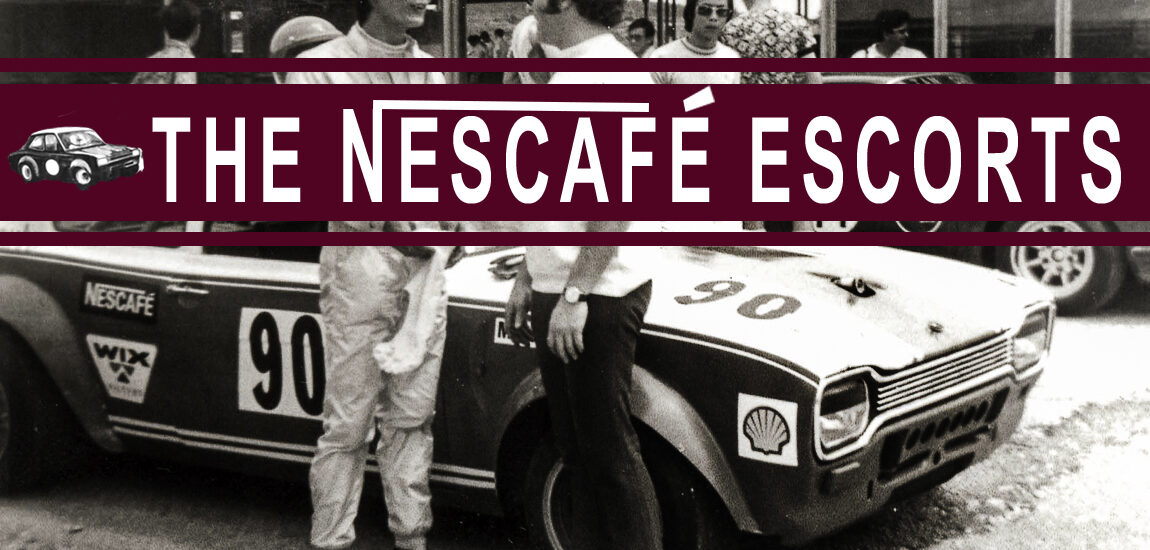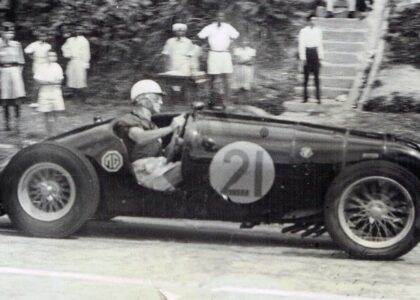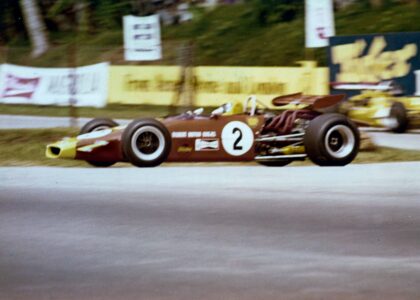“The art of good motor racing is…I’m going to call it the eleventh commandment… Thou Shalt not get caught breaking the other ten.” Bill Santuccione
Words by Eli Solomon
Updated – 27 January 2022
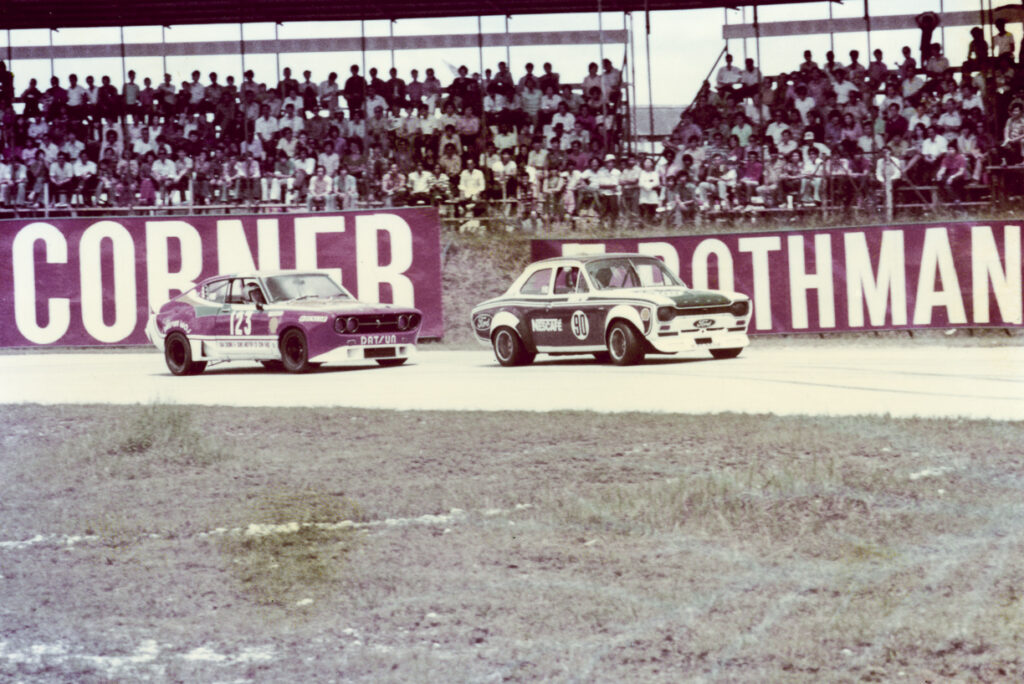
We all know the names Allan Moffat and Harvey Yap, both synonymous with Ford’s racing exploits in Australia and the Far East in the early 1970s. But if you’ve never heard of Al Turner, you’re probably not into Ford’s saloon car racing exploits in the Far East. Which probably means the names Bill Santuccione and Leonard Lim Khing Fong (known simply as LKF) won’t mean anything. These three individuals weren’t just a supporting cast but an important part of the business of motor sports in Asia.
This article is an attempt to enlist the entire cast involved in that very exciting period of racing in South East Asia, a short history this writer refers to as the Pre-Big Bang of Saloon Car racing in the Far East.
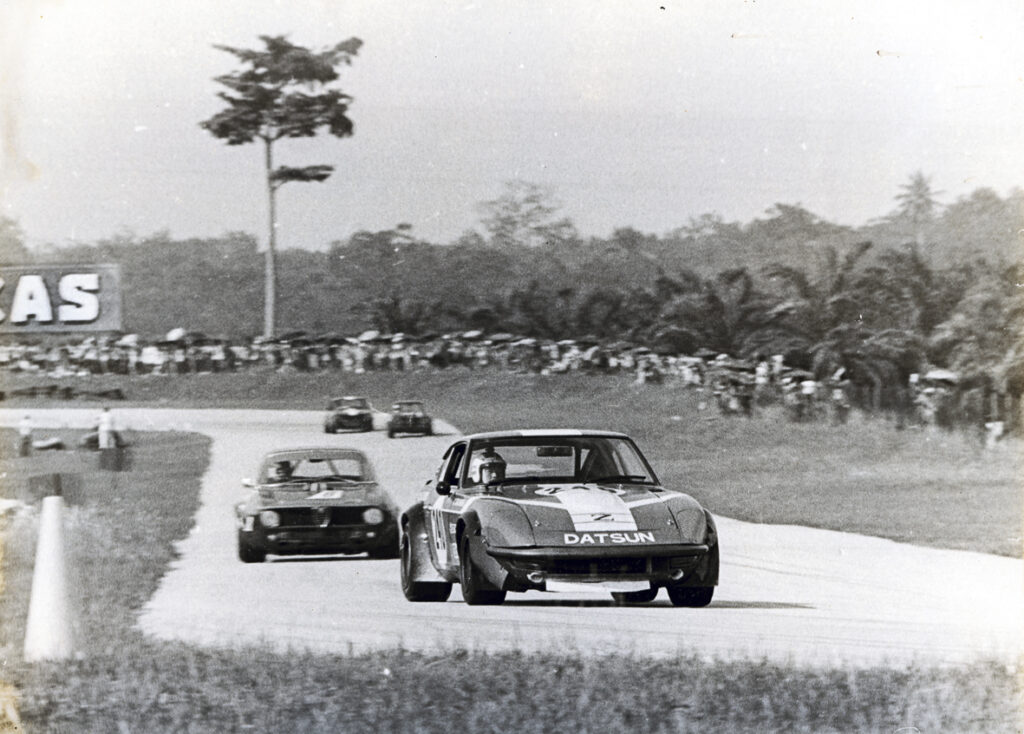
To appreciate how Harvey Yap came to dominate Saloon car racing in our neck of the woods we shall have to study not just Ford Motor Company’s local presence but also the developments globally, with particular emphasis on Australasia. What is presented here is an attempt by an amateur historian with a genuine interest in the sport. Let’s call it a snifter, albeit a 12,000 word one. Hopefully it will spark an interest amongst the racing experts and documentary makers and result in a more detailed study of this very interesting era of the sport and perhaps, as farfetched as this suggestion may seem, lead to a biopic on one or more of the personalities featured.
So let’s see if we can restore a very small part of a very large canvas and, and in the process, debunk certain myths about the constellation of cars (and especially of the works Ford Escorts) that turned Saloon Car racing in the Far East on its head. In the process we may also end up with a better picture of the pre-Big Bang of racing in the Far East, of how the Saloon & Tourer racing class morphed into Improved Touring Cars, and later into Super Saloons and Silhouettes.1
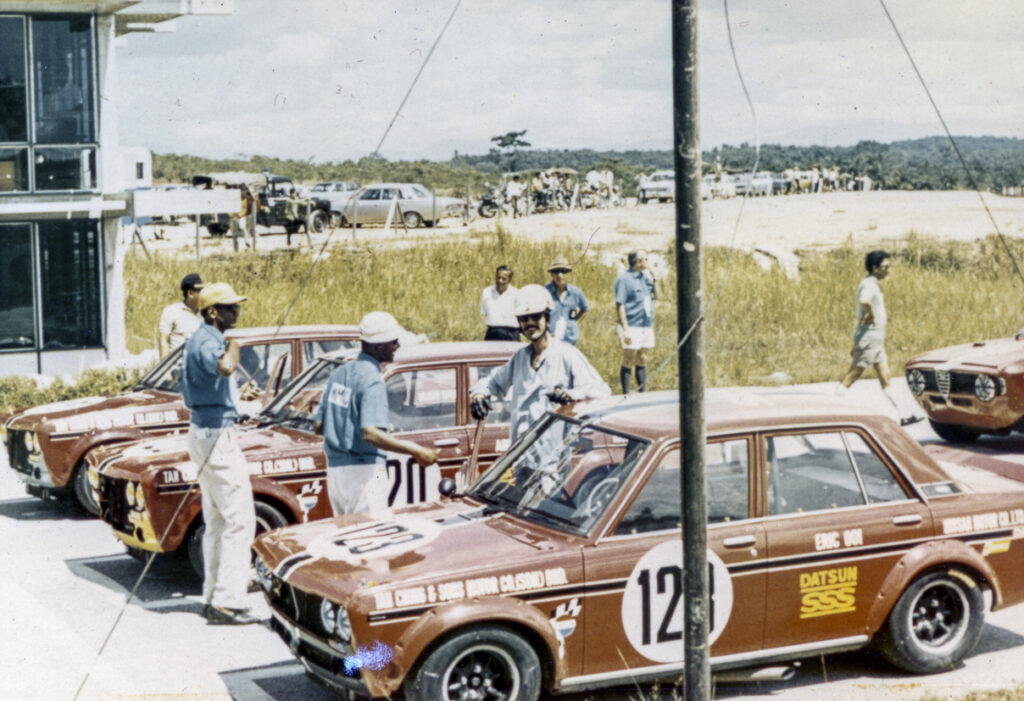
GENESIS
GENESIS: To understand what was going on in saloon and touring car racing in the Far East, two major developments have to be looked at. The first was the establishment of a permanent circuit in Selangor, just 16 miles from Kuala Lumpur on a 250-acre area plot in Batu Tiga provided by the Selangor State Government. The circuit was opened in August 1967 [See Racing In The Federal Capital]. The second was the growth in demand for the automobile in the region and how the car companies were positioning themselves in two rapidly developing economies.2 That’s a bit more complex a story than we have room for here.3 And since our focus is on Ford and the Nescafé Escorts, we’ll touch briefly on Ford’s special vehicle operations in the southern hemisphere.
SKUNK WORKS
SKUNK WORKS: In the late 1960s and early 1970s, Ford’s Asia Pacific business (called FasPac) was run out of Melbourne, Australia. The business was separate from the company’s motor sports operations. FoMoCo’s operations were at Broadmeadows in the Australian state of Victoria, while the racing boys operated their secret lab out of Lot 6, or more precisely, Ford’s “Skunk Works” at Mahoney’s Road, just across from the Broadmeadows HQ.
Here, at this nondescript red brick structure, surrounded by cyclone-wire fencing and a locked gate, Lot 6 was housed and here is where Big Al A. Turner would turn up after office hours and work with his select team to create the famous Falcon GTHOs and other interesting touring racing cars.
A bit of background first. Let’s meet American Big Al Turner whom Allan Moffat referred to as a ‘hot-rodder’. He was also referred to as Al “Big Smoke” Turner and has been credited with being the “Father of the Funny Car”.4 In the 1960s, Big Al was a familiar name in Ford’s Lincoln-Mercury Drag Program in the US – i.e. the Mercury Comets – Pro Stock, Gassers, Funny Cars, the whole kit and caboodle. Down Under, FAPSA’s (Ford Asia Pacific & South Africa) President Bill Bourke was looking to rapidly grow the Muscle Car segment of Ford’s business and Ford’s President, Bunkie Knudsen suggested Al for the role. In 1969, Big Al, then 37, was parachuted into Victoria to run the youth and performance marketing division for Ford Australia, a market that was seen to be a good four to five years behind the US.
When the ‘big-talking’ charismatic Burke was posted to Ford Europe, Big Al assumed the role of chief of Ford Asia Pacific (FasPac), sequestered over by Bourke. Big Al was also tasked with developing an AUV, a multipurpose, low budget vehicle for the South East Asian market, codenamed the B.C., or Bullock Cart (what was officially known as the Fiera). The origins of this project began at Ford’s Broadmeadows assembly plant in Victoria with a dozen engineers set aside to work under Bourke.5
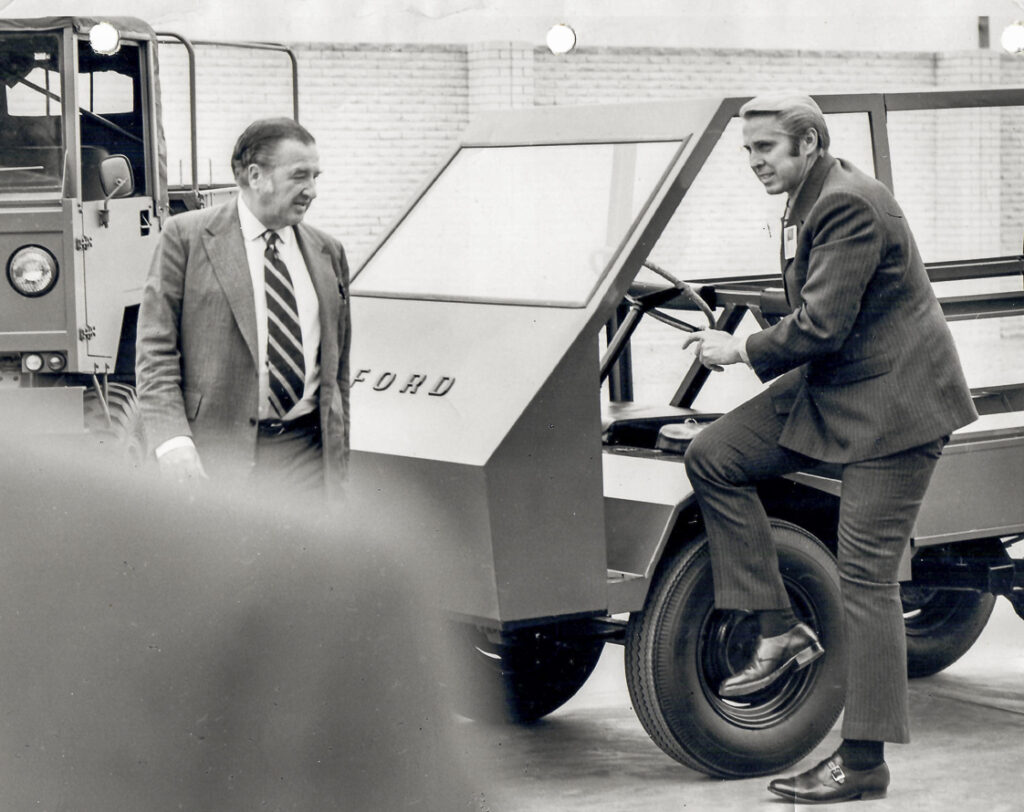
Meanwhile, Al, a big fan of drag racing, had also been deeply involved in the development of the racing program. He set about establishing this “secret lab” and recruited a crew, mainly ex-Repco-Brabham men from RBEC (Repco-Brabham Engine Company)6 who had been with the company when Brabham won back-to-back Formula 1 world championships in 1966 and 1967. Men such as Repco’s draughtsman Ian Stockings (who stepped away from the racing side to oversee the Fiera AUV program in the Philippines) and engine man and Foreman, Bill Santuccione joined. The lab was located at Lot 6 and Bill was Lot 6’s employee Number 1. Bill features a great deal in our story, once Big Al entrusted him with the role of Racing Programs Manager for Asia Pacific.
FAR EASTERN TIN TOPS
FAR EASTERN TIN TOPS: While all this was taking place Down Under, in Malaysia and Singapore Datsun ruled the tin top roost with its Bluebird 510 Triple-S – in races and in sales of vehicles. Yes there was the odd Alfa Romeo GTA/GTAm but look at the front of any of the saloon car grids in the early 1970s and all you see are Dat and the rising suns, 510 Bluebirds and later on, turbocharged SSS 160J Coupes. In the very early 1970s it was Datsun’s Masohira Hasemi and Kenji Tohira show before it became the Kunimitsu Takahashi show. That was until 1972 when lightweight was met with a couple of Escorts with Cosworth power.7
At Ford’s Special Vehicles Lot 6, Big Al conceived a pair of monster GTHOs, Howard Marsden later ‘mothered’ them, John Wynne hand built them, Ian Stockings engineered the motors and Bill Santuccione put them together – all in secrecy in early 1970s. These guys were good! And here’s where the great Allan Moffat comes into picture.
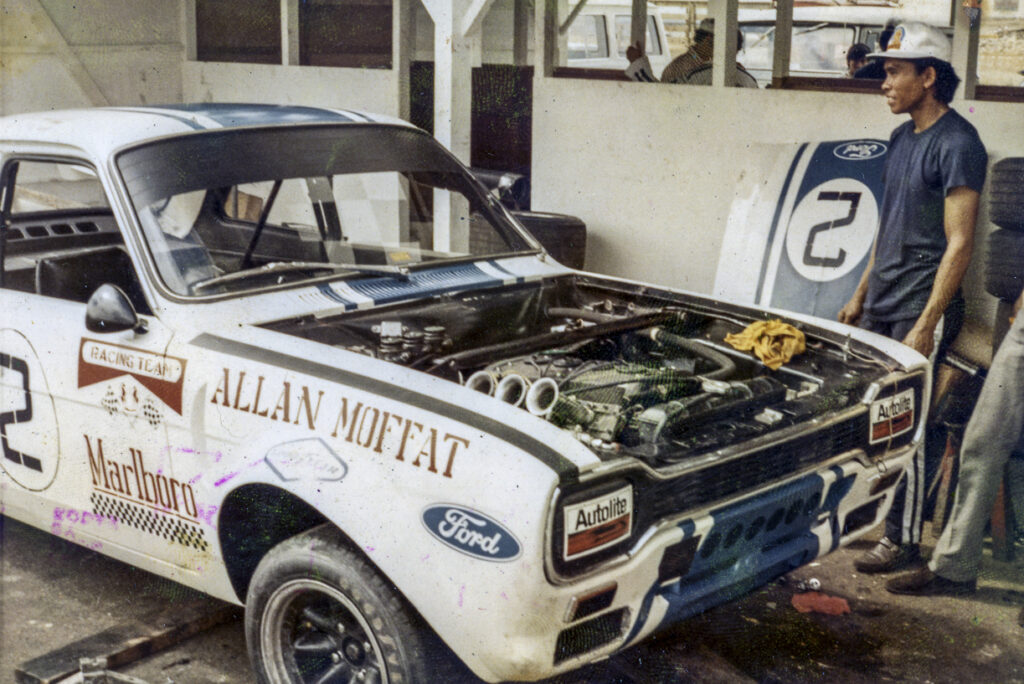
ACT1, SCENE 1
ACT1, SCENE 1: Let’s introduce Allan Moffat to our story – at the second Greenhills Philippines Grand Prix at the end of January 1972. The races were for Saloons and Formula Libre cars as well as an Enduro for locally assembled cars. FasPac were hard at work on the AUV, the B.C. What better time then to introduce the work of Lot 6 and one of Australia’s top saloon car specialists to the Philippine and South East Asian markets and boost Ford’s presence in Series Production endurance races. Bill Santuccione recalls that it was Al Turner who decided to attend the races at Greenhills.
“I came up several weeks before and it way my responsibility to get all of the dealer cars and the privateers who wanted to be involved to be as successful as possible. That very first event we got seven cars placed in the first ten, which was all very well received,” recalled Bill.
The saloon race car Al Turner sent over was a two-door Ford Escort with 9in wide rectangular headlights (as opposed to models with 7in round headlights) and a Cosworth FVA motor. Ford’s Escort models were already well known in Asia (the base models were assembled locally), and by 1971 and 1972, were one of the most popular saloon cars money could buy in the region. More importantly, you didn’t need a language translator to order juicy upgrades for the club sprints and hill climbs. You simply had to head over to Newton Enterprises or one of the other performance conversion shops in Singapore, Kuala Lumpur or Hong Kong and buy a Weber kit. Plus you have a burgeoning saloon and rally scene in Europe that gave you numerous upgrade options – from the superficial to the more serious BDA or Twin Cam motors.
FORD CONSTELLATION
FORD CONSTELLATION: Allan Moffat was tasked with piloting the Lot 6 racing Escort. His crew included Big Al and Bill Santuccione. Moffat had already participated at the 1971 Macau Guia race in November that year, in a Lot 6-developed Ford GTHO. Al Turner told this author that it wasn’t the Escort that was sent to the Philippines wasn’t the Holman and Moody car that sat at the H&M workshops. Allan Moffat8, states otherwise:
“Ford was keen to push its small 1.6-litre Escort in the region and they’d bought a stove-hot version of the car to Australia for me to drive in 1970, alongside the Falcon GTHO and my own Mustang.
“It had been built by the Alan Mann team…and a similar car had carried Australia’s Frank Gardner to the British Saloon Car Championship in 1968.
“’My’ car had at first been sent to the United States, but when Ford’s plans shifted up a gear to go Trans Am racing, it had sat in a corner of the workshop of Holman and Moody, one of Ford’s racing teams. Al Turner knew it was there and brought it to Australia for me to race in what was the predecessor of the Australian Sports Sedan Championship…”
The blue with white bands Escort was soon painted in Coca-Cola red – by the second race meeting Moffat used the car. So perhaps Big Al was correct – the Escort mentioned in Moffat’s autobiography may not have been the blue-white Cosworth FVA-engined car that arrived in Manila for the 2nd Greenhills Grand Prix over two weekends at the end of January 1972.
Perhaps there were two Escorts at Lot 6 and one was a Series Production race car. But that’s a moot point in this article except for this writer to add that the Greenhills car had an FVA motor and was the car Moffat would race at Oran Park in March 1972, identical in every respect (it had no quarter glass) to the car that was flown to Asia that January. Granted that the “Coke” coloured car from Holman and Moody may have been lightened further (the original car had front quarter glass on both doors).
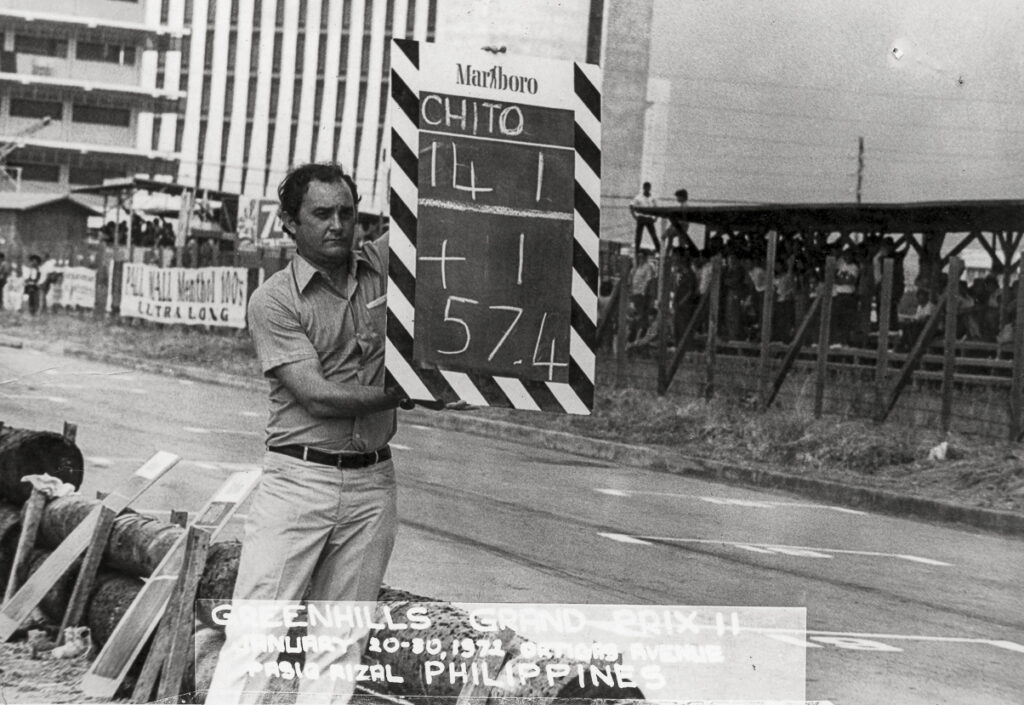
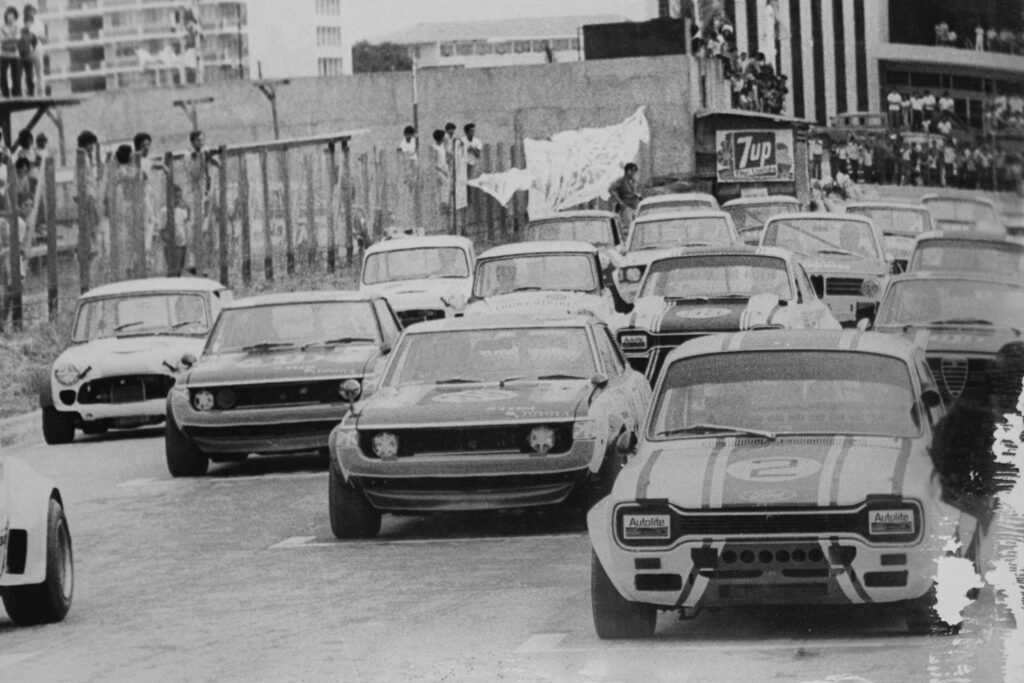
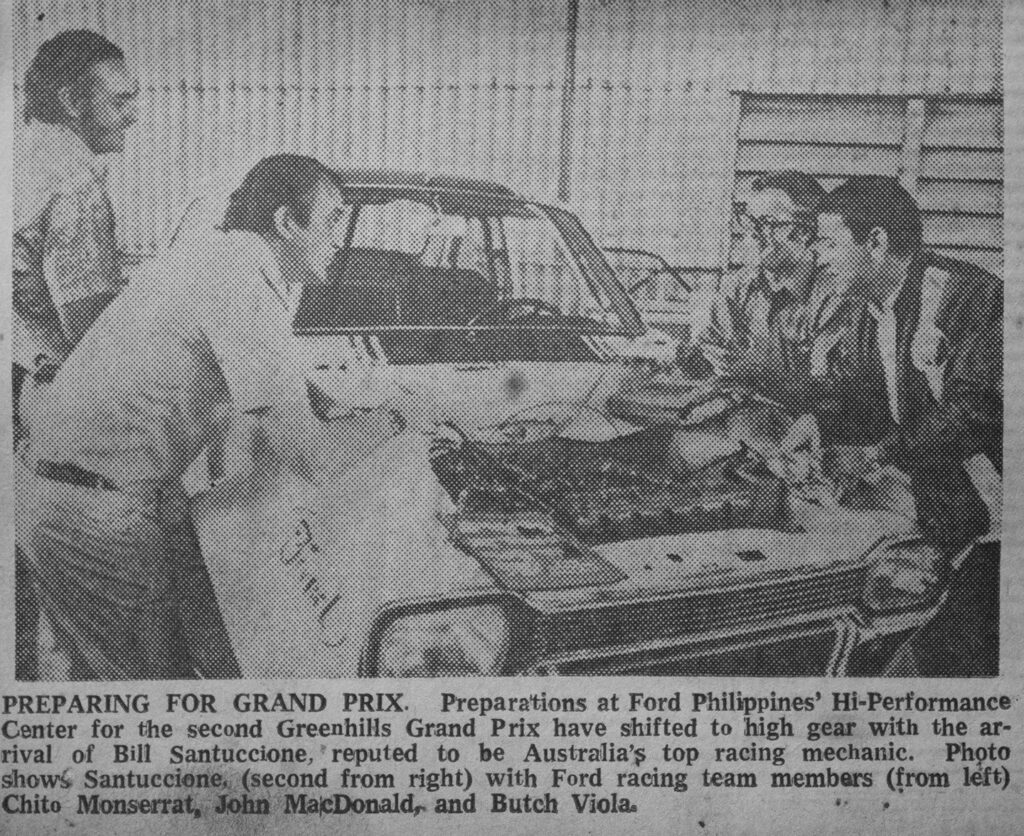
Racing in Manila was entirely different to what Moffat had been used to in America and Australia – it was just as much fun but with idiosyncrasies that must have frightened the foreigners as Moffat recounted in his autobiography. The 1972 Greenhills Grand Prix was a street run race with some distributor entries from Team Toyota and Delta Motor Sales (Toyota), Apex Motors (Mazda) and Ebrada Motors (Buggies). There were Ford Escorts entered – Chito Monserrat’s Escort 1600 GT and Arthur Tuason’s 1300 GT, for example, were attended to by Bill Santuccione as part of the company’s assault on the Production Series races. Even Hong Kong’s John Macdonald was involved – racing a Ford Escort BDA in the Saloons race and playing the role of Ford Team Manager for the Enduro.
FasPac’s ministrations must have been more with utilitarian matters but there was room for some racing in these foreign lands. The race didn’t work out so well for Moffat nor did it for Macdonald. Moffat finished behind Dante Silverio in a 1600cc TA21 Toyota Celica which the Manila press described as “…So new, you could smell their paint jobs. So new they had to be driven right hand side.” But Ford’s management were happy with the outcome – near total domination in the Series Production event.
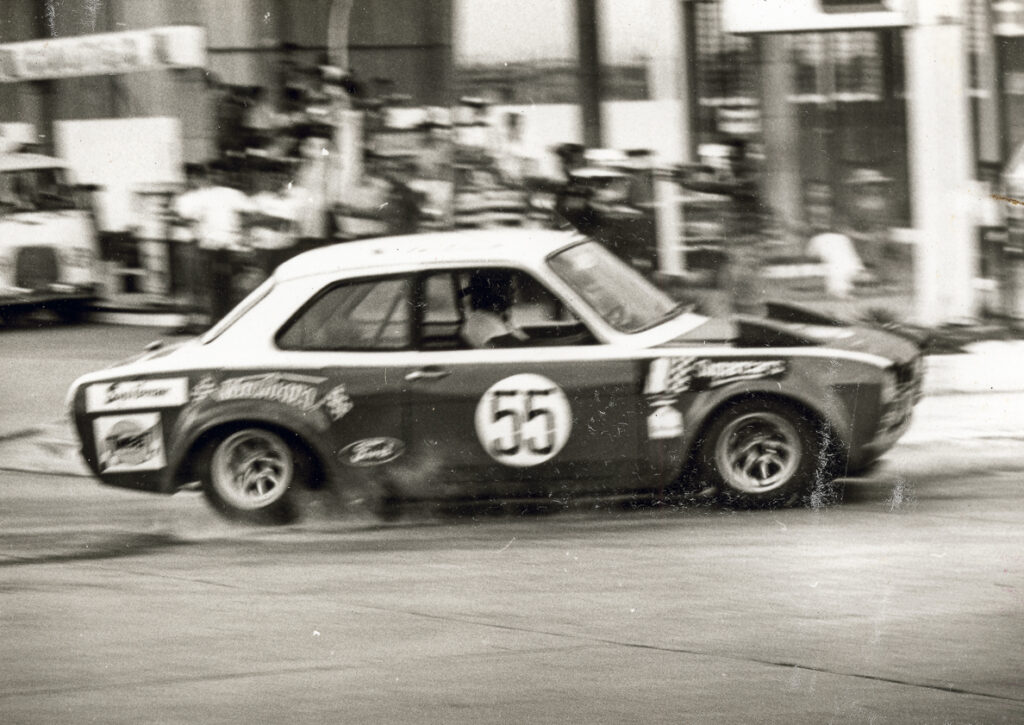
The rectangle headlight car needed more work back at Lot 6, and thus began the development program with even wider wheels, suspension work and a new colour scheme, the white with blue stripes swapped over for blue with white stripes for it next Asian trip. The FVA was retained but there was now a bonnet cut out to accommodate the front cam-driven fuel injection pump, evidenced in the 1973 photographs.
There have also been suggestions amongst the local experts that the Moffat car was the #133 Bill Fanning Ford Escort (the Ian Hindmarsh Escort) that won in Singapore in March 1972 and at Batu Tiga in April that year but it is unlikely that this was the case as Fanning revealed that the Twin Cam Escort was his own car, facilitated by P.H. Wong’s Newton Enterprises and sponsored by Ford Singapore for his trip to race in Singapore, Batu Tiga and Penang in 1972. The Fanning car too had rectangle headlamps but ran a Merv Waggott-modified Cosworth FVA engine. Fanning’s 1972 South East Asian entry was a last minute one for the Saloon and Tourer race. He had come with seven outright wins out of 15 races in Australia in 1971 and weighed just 1600lbs. It pushed out 250bhp via a five-speed ZF transmission and, according to Bill Fanning himself, was shod with McLaren vented disc brakes all round. Bill Santuccione corroborated this.
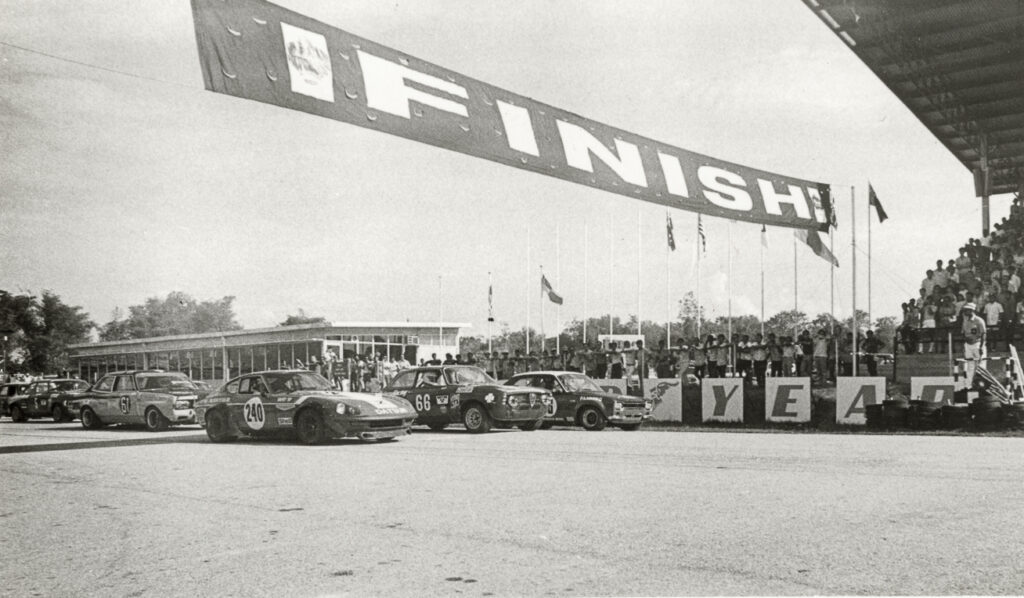
ACT 1, SCENE 2
ACT 1, SCENE 2: Fast forward to 10-11 March 1973 and the third Philippines Grand Prix at Greenhills in Manila. Allan Moffat was entered once more by FasPac. The #17 Ford Escort was now painted blue with white bands. Somewhere or other it was stated that the car had an injected 2-litre Brian Hart BDA, the injection unit visible in photos of the car. The Ford team was faced with a different dilemma however. The organisers wanted a more equitable balance of performance and the lightweight 1800lb Escort was penalised with 400lb of ballast in order to qualify for the Saloon Car race. Be that as it may, the hot favourite sprung a fuel leak a few seconds after the flag dropped and that was it for Big Al and Allan Moffat’s race weekend.
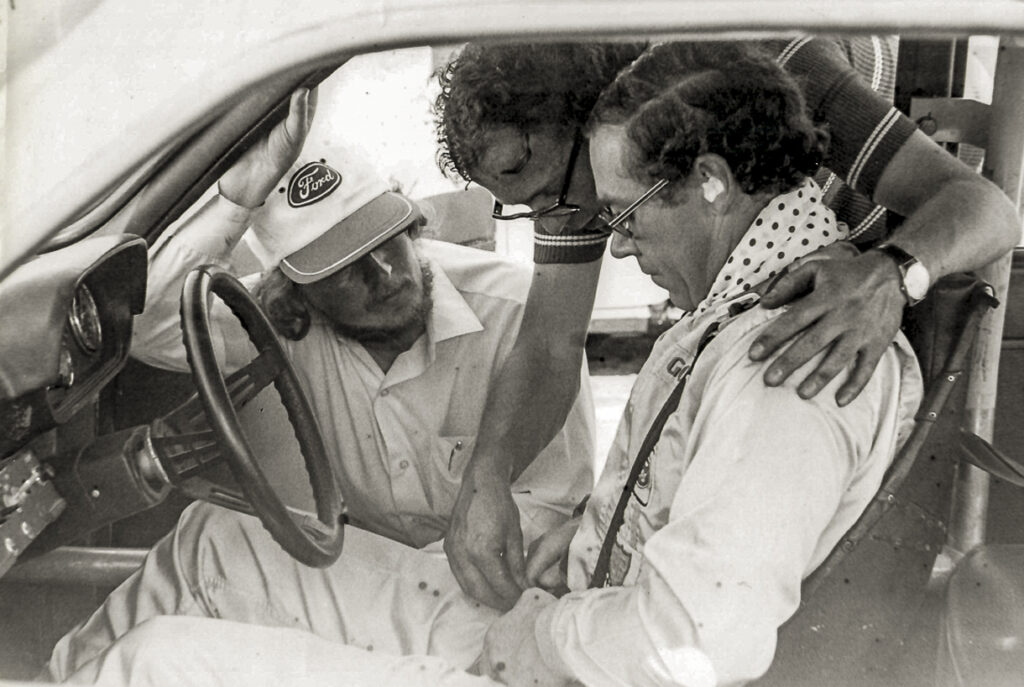
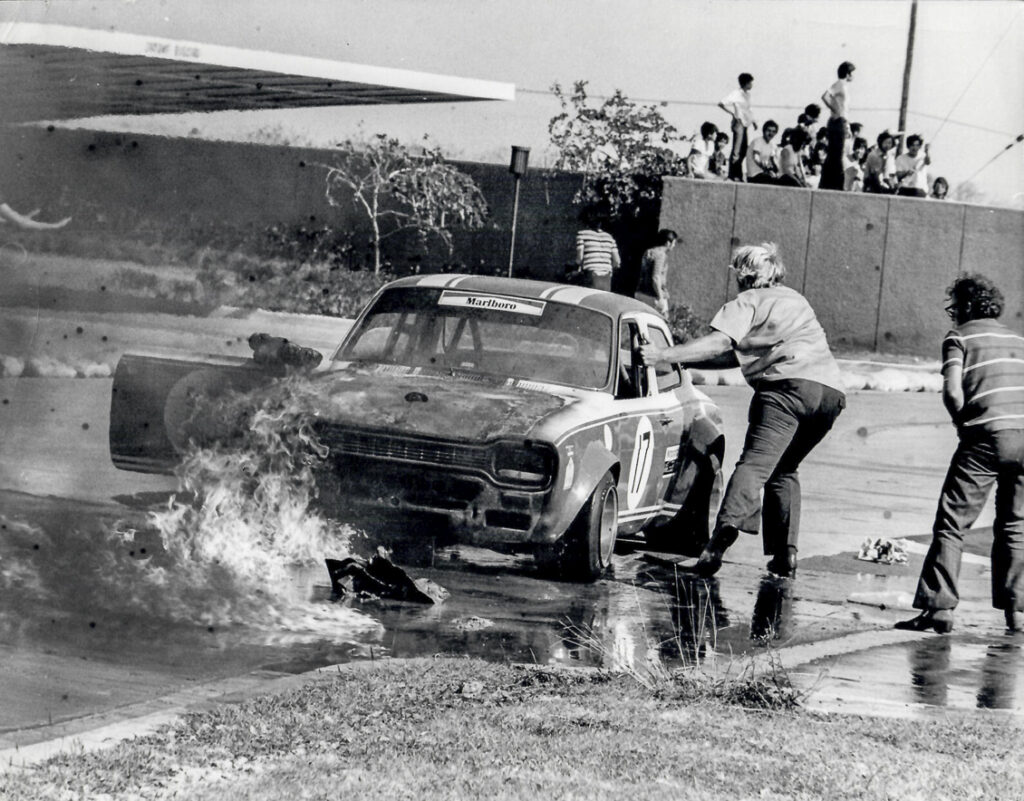
Bill Santuccione was right on the case, renting a garage in Manila and sending for tools from Lot 6 for some quick attention. What happened immediately after is not clear but on the evening of Monday, 9th April, two Ford Escorts arrived at Paya Lebar Airport in Singapore aboard a BOAC 707 passenger-freighter with Bill Santuccione as passenger. One was the #20 Lot 6 Escort (for Allan Moffat), the other was the #24 orange Globe Products of Adelaide Escort BDA complete with crew (for John Basset, son of the Globe Wheels owner). Both cars were trailered across the border to Kuala Lumpur for the Malaysian Grand Prix held 14-15 March and then back to Singapore for the Easter Grand Prix, then back up to Penang for the Penang races in May. It was a one-off for the Globe Wheels team, part of Al Turner’s plan to add impetus to Ford’s Asian racing program.
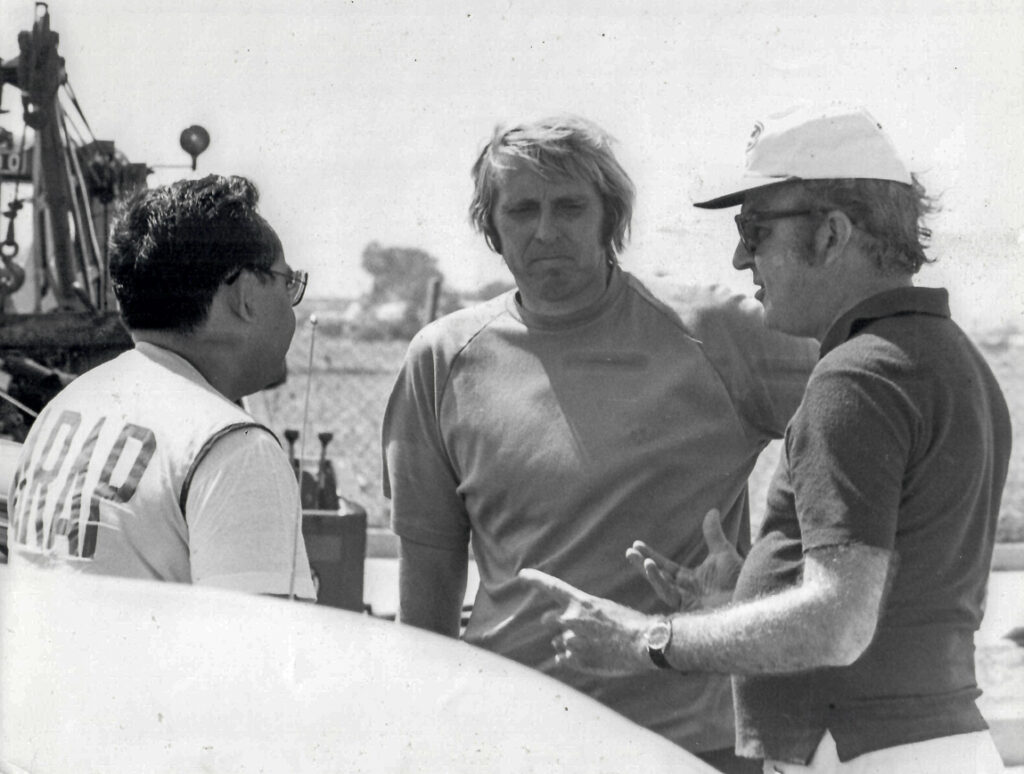
RISING SON
RISING SON: Ford’s star driver was preoccupied with the Australian Touring Car Championship race at Sandown International Raceway in Melbourne that coincided with the Malaysian Grand Prix weekend (Moffat won at Sandown in an Ansett/Motorcraft/BP sponsored Ford XY Falcon GTHO Phase III). Fred Gibson, another of the works drivers from Lot 6, was entrusted with the car for the Saloons & Tourers race at Batu Tiga as he wasn’t in contention for the overall ATCC Championships.
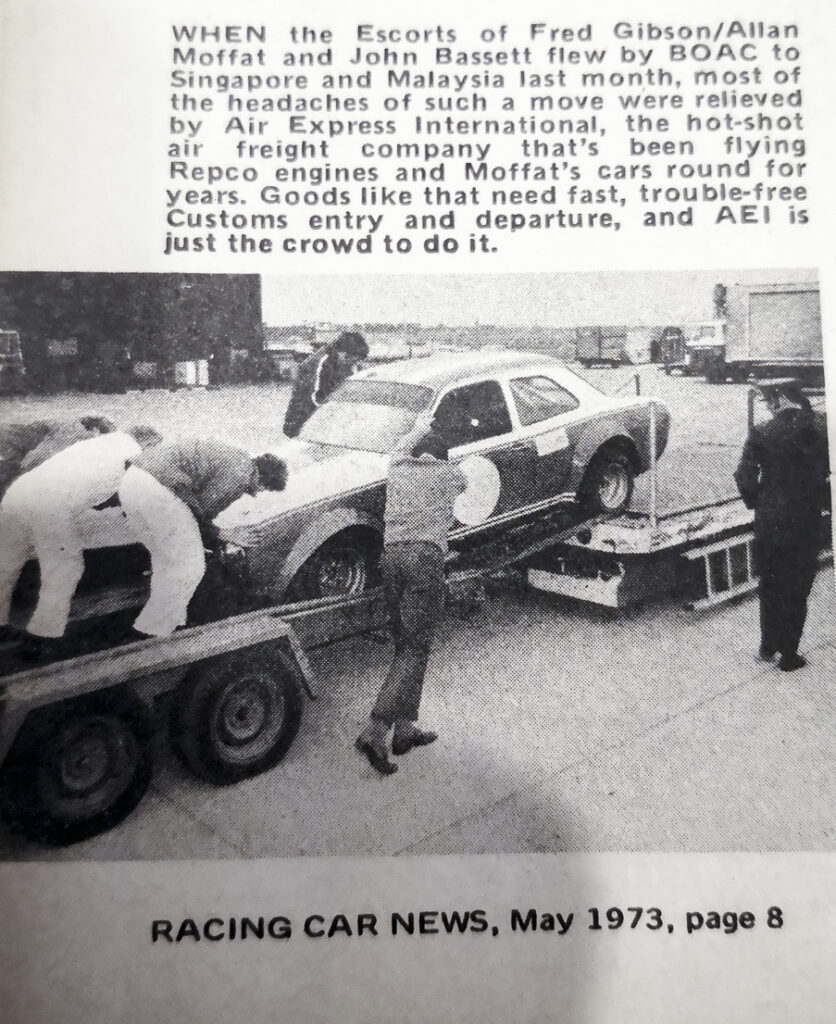
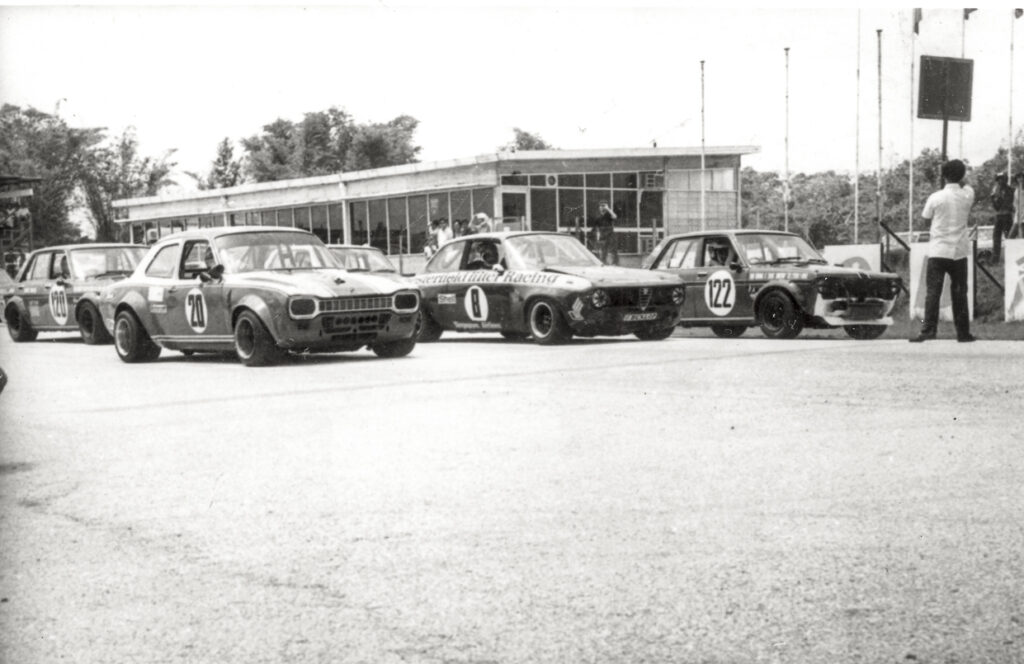
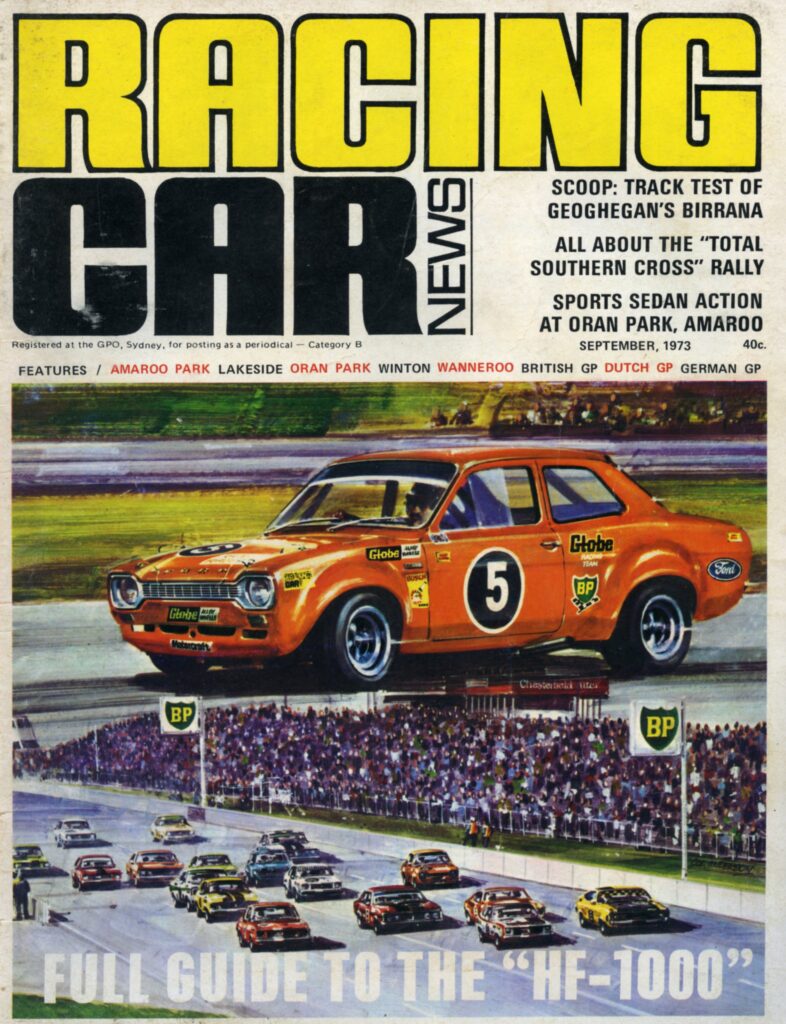
Gibson’s competition at Batu Tiga would come from Australians: Brian Foley in his Chesterfield Racing 2-litre Alfa Romeo GTA Super Lightweight (a GTA with a 2-litre GTV block, a 16-valve head from a Formula 2 engine, lightweight Formula 5000 front suspension and a rear suspension with modified shock positions, magnesium wheels and overall weight of 1400 lb/~630kg) and John Basset in the orange Globe BDA Ford Escort. There was an unknown entered. Local resident Ian Grey, also an Australian, had a Porsche 911S, with a 2.4-litre flat-six motor. The crack Japanese drivers were preoccupied with their home Grand Prix so Team Datsun were left with their local drivers instead.
In the meantime, local favourite Harvey Yap had what certainly looked like a Group 4 works Datsun HS30-H Fairlady 240ZG to play around with, though this was in the Sports & GT races where his competition included a bunch of aged British sports cars (including a 3.5-litre SS100 Jaguar!), three other stock Datsun 240Zs, a 7-litre Corvette and a pair of 911S. There was a Chevron B8 entered, and in the right hands and good mechanic, could have posed a threat to the works 240ZG. Harvey was in a different league to the rest of the grid – after all, he was a professional in a grid made up of enthusiasts, albeit some very good ones.
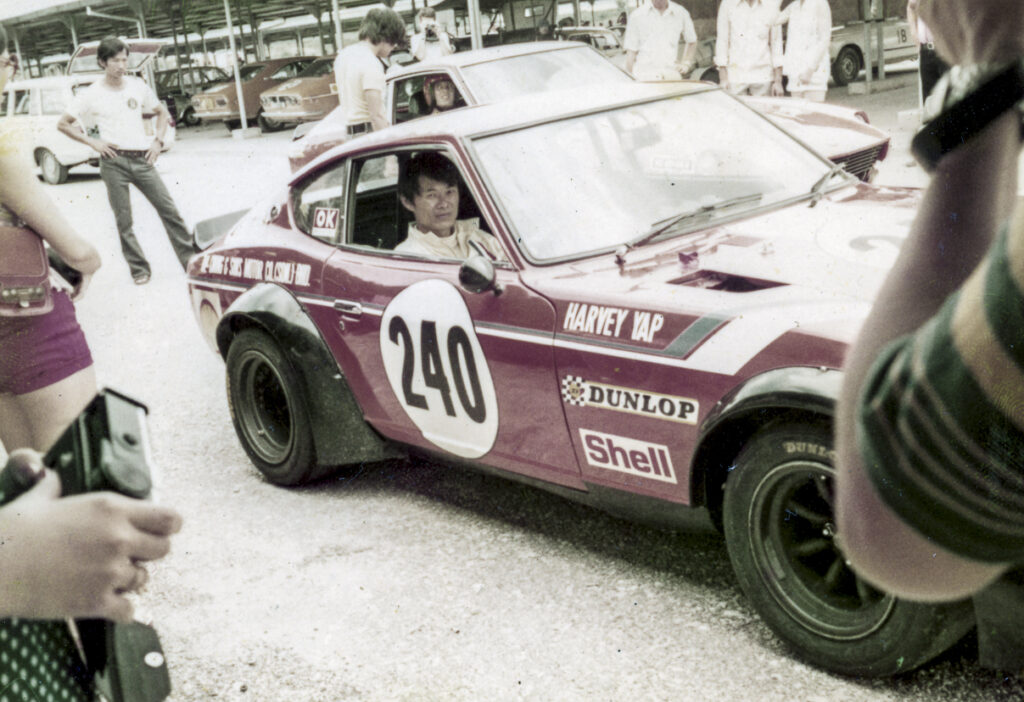
In the Saloons & Tourers race Gibson started the 25-lap race in pole, safety studs holding his low profile tyres securely in place. Foley was next to him in the Chesterfield 2-litre GTA with John Basset in third in the second Ford Escort although photos from the start show Datsun #122 in third place on the grid. Gibson had gear leaver issues that slowed him down – he was classified with 5th place while Ronnie Loong took the win in a 1,595cc Datsun 510 SSS.
ARTIFICIAL ASPIRATIONS
ARTIFICIAL ASPIRATIONS: A quick glance at the official 1973 Malaysian and Singapore Grand Prix programs and one notices the Gibson and Moffat entries with the car listed as a Ford Escort RS, engine capacity 1974S cc, which was rather unusual. The ‘S’ in the entry denoted that the engine was supercharged. Bill Santuccione knew it as a very unique motor but was this a 2-litre BDA instead of the previously run FVA (in 1972)? So were Al Turner, Bill Santuccione and Allan Moffat up to the same trickery played by Alan Mann’s AMR outfit only a few years earlier? Typically, race teams would have looked for regulation loopholes – adding a fan blowing into the intakes and having this rated as being supercharged might had resulted in the car being bumped up to a higher capacity category in a race or race series and this in turn might have permitted the team to modify other parts of that car etc. In the case of an FVA-engined Escort, it was probably an issue over homologation as the Escort may not have been homologated with a Cosworth FVA motor (it had been homologated with the Ford Twin Cam and later on with the BDA).
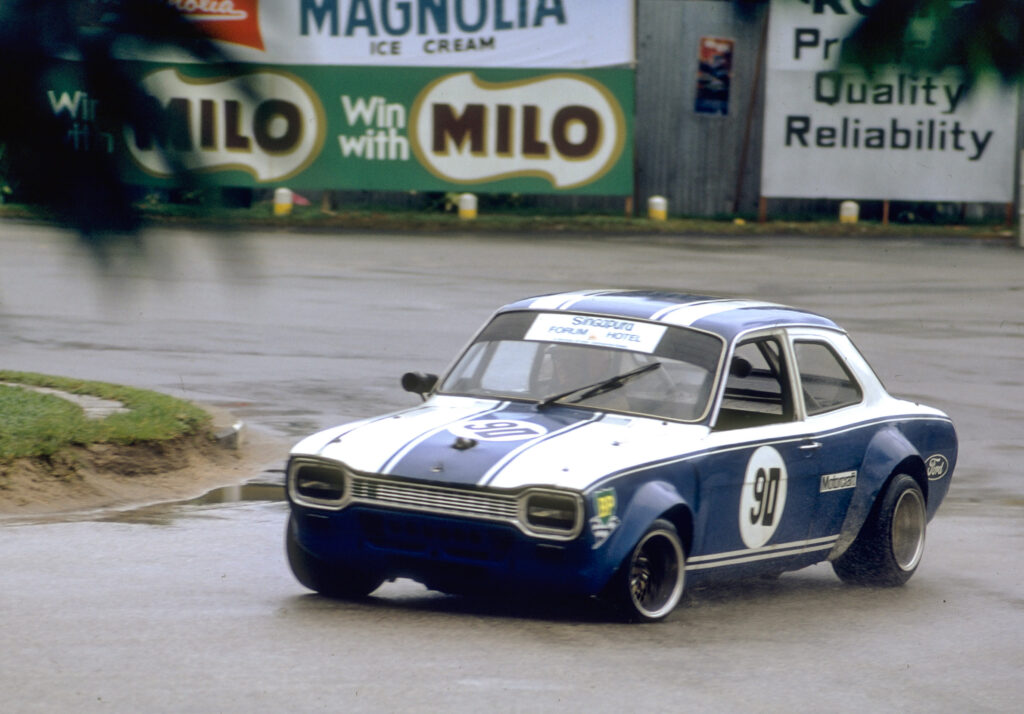
TALENT TIME
TALENT TIME: Ford Malaysia were now in on the FasPac act and Big Al must have realized that a good local racer would have been able to do what Allan Moffat did for Ford’s tin top racing program in Australia, even though Moffat was Canadian, from Saskatoon.
Harvey Yap was in a different league to the local crop of drivers and had already spent three weeks in Japan in February 1972 under the tutorship of Nissan’s Kunimitsu Takahashi. The defection greatly upset the Japanese but Al managed to wring it and Harvey joined Ford from Tan Chong Motors, Datsun agents for Malaysia and Singapore. It was a defection that would have serious ramification at the sharp end of the Saloon Car grid in Malaysian racing for years to come. It was hard to beat a salary package six-times what the Field Manager was getting paid at Tan Chong Motors. Harvey later admitted of Takahashi: “He taught me everything he knew, including racing psychology.” It paved the way for heir apparent Lee Kwai Leong to take over as the local Number One in the Datsun line-up that included Malaysia’s best tin top drives – Abdul Malek and Eric Ooi etc.
So while everyone packed their bags for a few idle weeks after the Singapore Grand Prix, Ford were finalizing plans for their new driver and a new paint scheme for the Escort. The car got a smart makeover and voilà; it arrives at the Penang Esplanade in brand new Nescafé livery two weeks later, in time for the 5-6 May Penang Circuit Races. Moffat, easily the fastest of the saloons in Singapore, had issues with the low profile tyres deflating. Likewise, Harvey Yap stormed to pole in the Saloons and Tourers qualifiers, ahead of Albert Poon in his City Motors GTAm and Ian Grey in his 2.4-litre Porsche 911S. It was Harvey’s to lose in the main race, which is exactly what happened when tyre deflation raised its ugly head once more and the Escort DNF-ed with a puncture9 and a bungled pit stop just four laps from the finish. Billy Mei drove a steady race to a surprise win in a Sparstune Mini Cooper.
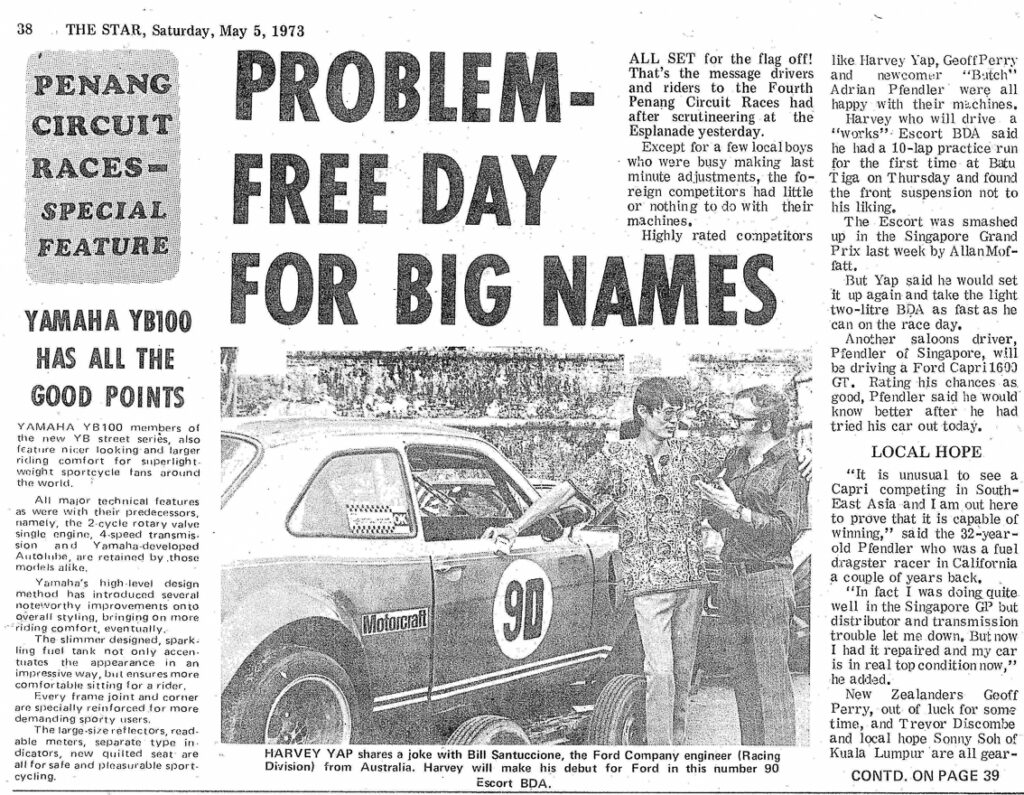

IMPROVING THE BREED
IMPROVING THE BREED: There was a long wait till September for the next big event for the Nescafé-Ford Escort (the 8-9 September 1973 Selangor Grand Prix) and just enough time for a quick trip back to Lot 6 for even further improvements. Back in Victoria, Bill took the car around Calder Raceway for testing following some suspension work. A mechanic had inadvertently left a screwdriver in the engine bay when Bill took the car out for a test run. The tool was sucked into one of the sliding throttle bodies and the throttle jammed open. Fortunately Bill was able to cut the engine before too much damage had been done on the off-track excursion.
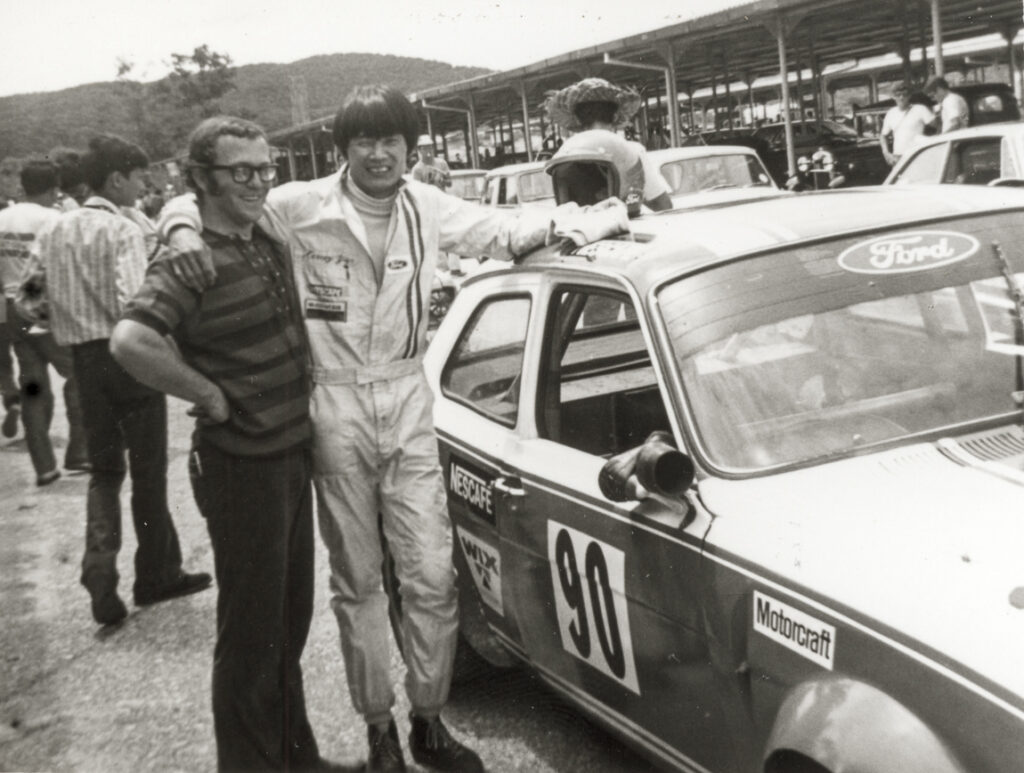
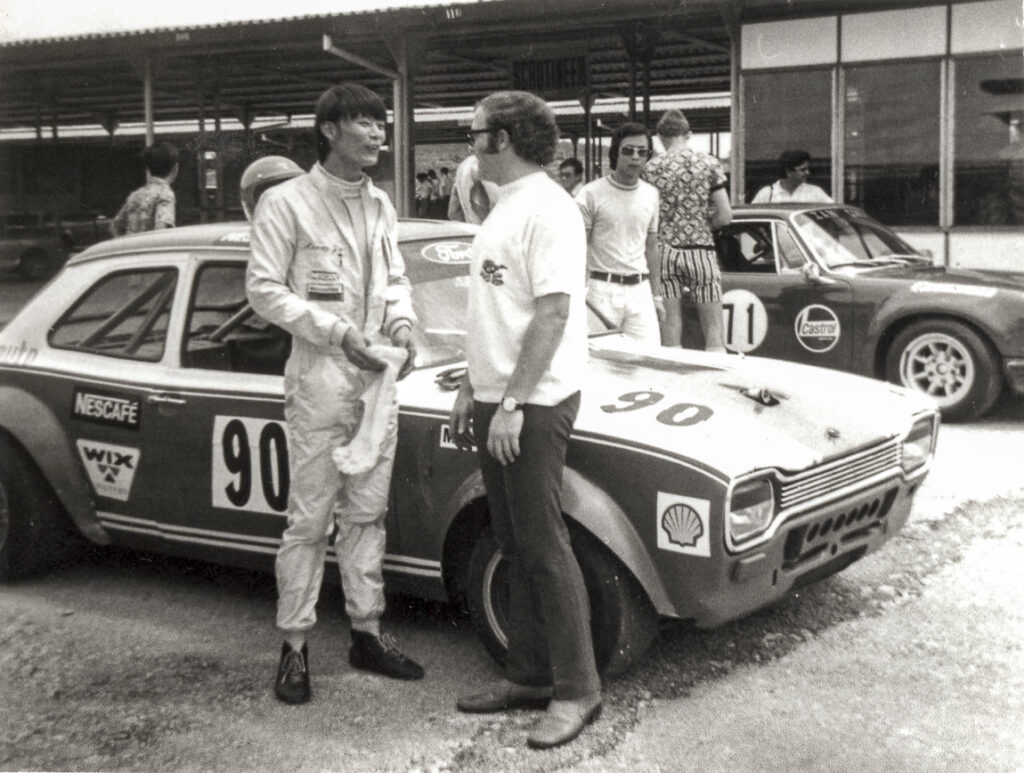
The 1301cc and over Improved Touring Cars had a single heat of 10 laps on Saturday, 8th September and a 25 lap race at 1.45pm on Sunday, equivalent to 52.5 miles in searing tropical heat. It wasn’t a big grid, just 11 cars with familiar names like Kenny Lee (1.6-litre Datsun SSS); Eric Ooi (1.6-litre Datsun SSS); Abdul Malek (1.6-litre Datsun SSS); Albert Poon (Alfa Romeo GTAm); Victor Wee (BMW 2002 Ti); Ian Grey (Porsche 911S 2.4); Jim Pinkley (3-litre Holden Torana); Dick Jordan (7-litre Chevrolet Corvette Stingray); and Harvey Yap in the Ford Motor Company Nescafé Escort. No Takasashi, Moffat, Gibson, Collingwood, Fanning, Basset or Foley provide serious competition for Harvey and the Escort. Yet it wasn’t an easy victory for the Ford entry because the car was plagued with a persistent air leak in its split rims, ruining qualifying and resulting in a quick change of wheels to standard Mini-Lites. Harvey’s times in the heats still put him on pole position with his friend Eric Ooi alongside in a Datsun SSS and Ian Grey in third in his 911S. But tyre issues continued to plague the team and yet another puncture knocked the car out of contention just four laps from the end.
And so ended the first season in Malaysia for the V1 works Ford Escort entry. The car returned to Lot 610, the dust settled and everyone looked forward to the National Championship races in December. Time to regroup, see how the oil crisis would pan out and see if Nestlé would return with Ford for season two. Enter Team Nescafé-Ford Escort. But first, a bit of background on Nestlé’s Products (Malaya).
MILO, MAGGI MEE or COFFEE
MILO, MAGGI MEE or COFFEE: Nestlé’s Products (Malaya) marketing strategy in the 1960s included a heavy emphasis on sports where products like its Milo drink brand was heavily marketed. Nestlé’s Nescafé instant coffee was also very popular in Malaysia and Singapore so when the Malaysian Motor Sports Club put its hat out for support for the Batu Tiga permanent race circuit in 1967, Nestlé’s emerged as one of the key backers of the circuit.
The site of the new track was just 16 miles from Kuala Lumpur in a 250-acre area provided by the Selangor State Government. The design of the track was by committee of MMSC members led by Chairman John Brown (Also MD of Rothmans Of Pall Mall Malaysia). Substantial support came from corporates – Rothmans, Philips, Omega, Tiger Balm, Goodyear, Frazer & Neave, Cold Storage, Nestlé’s and Wearne Brothers – each contributing $500,000 (£59,000) between them. This sponsorship gave Nestlé’s naming rights to a section of the circuit, hence the original Milo Hill, after Caterpillar Corner and before F&N Bend.11
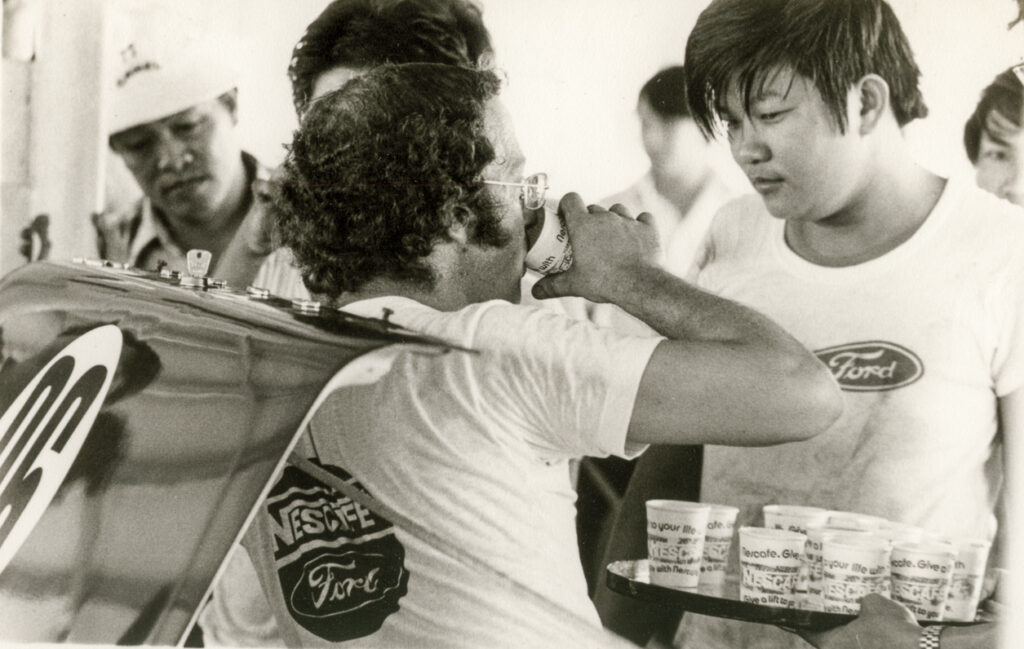
Leonard Lim Khing Fong, known simply as LKF, was Nestlé’s Malaysian Advertising Manager when Batu Tiga was first formed (he moved from the Singapore to the Malaysian office in 1963 as Assistant to the Marketing Manager) and it was through him that Ford and Harvey Yap were able to secure Nestlé’s Malaysia’s branding for the Ford Escort for Penang’s May 1973 Grand Prix. It was such a swift decision that the official program didn’t even have a race number for the car entered. LKF wanted the Nescafé branding on the car but it could easily have been called the Milo Escort or worse still, the Maggi Mee Escort instead.
Big Al left Australia in 1973 but remained with Ford until 1983 when he joined Chrysler Corporation’s “Special Projects” team (and developed the Viper). When the second oil crisis hit in October 1973 there were immediate ramifications in motor sports. On 25 January 1974, the Australian division of the Ford Motor Company announced that they were ending factory involvement in motor racing. Lot 6 was wound up and drivers like Fred Gibson and Allan Moffat went on to drive as privateers. Ford’s British motor sports operation at Boreham in Essex was also wound up and some of the stock (read cars) disposed of. While Singapore chose to slam the doors on motor racing altogether, up in Malaysia people were drinking coffee and Nestlé’s continued to back Harvey Yap and his Ford Escort for the 1974 season in Malaysia. Harvey was now Number One at Team Nescafé-Ford.
THE NESCAFÉ SHOW
THE NESCAFÉ SHOW: On the economic front things must have looked pretty grim when the world woke up to rising oil prices and inflation started to eat into pockets. Singapore and Malaysia were growing economies. There was a silver lining for Malaysian racing and it too was oil-related12 but that would be a few years down the road and has been alluded to in an earlier article [link to Super Saloon Big Bang – Part 2]. Would the 1974 season be affected by inflation and higher oil prices?
The Malaysian Grand Prix took place 6-7 April 1974 and it was fairly obvious that it was going to be even better than the 1973 Grand Prix. Rothmans of Pall Mall Malaysia were backing resident drivers in the Grand Prix for single-seaters. The MMSC’s Editor boasted that Malaysia was “one of the few countries in the world capable of holding motor races during this difficult period in the oil crisis…”
The race program always featured short blurbs of the top drivers and bikers in each of the classes of racing and once more, Harvey Yap was recognised as one of the top in the Improved Touring Car race, this time in a BDA “super Escort” from England that reputedly cost $100,000.
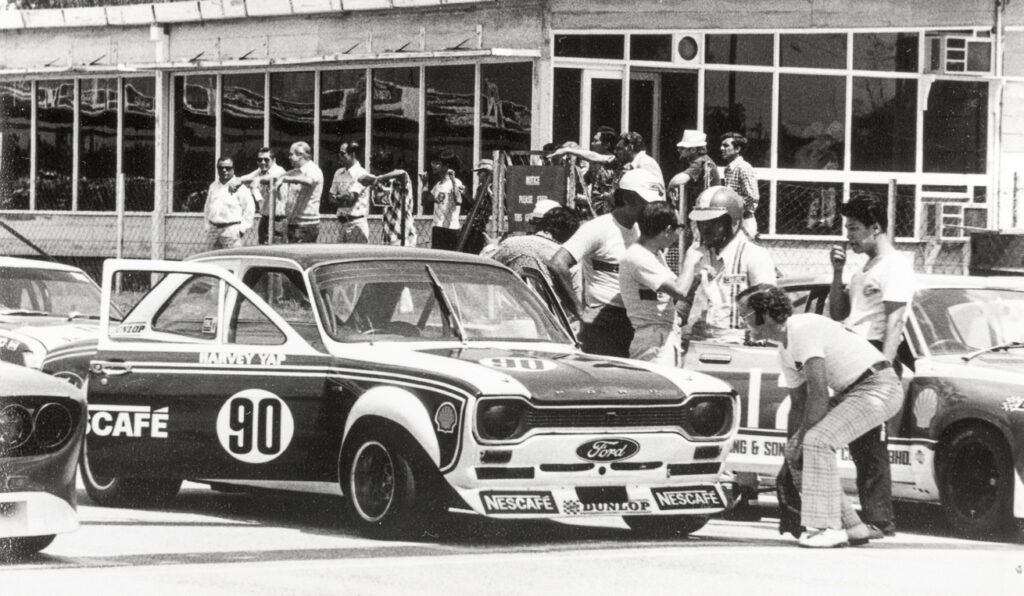
Bill Santuccione had been specifically sent to Boreham to get the second car13, the V2 Nescafé car, as the author prefers to call it. His point person at Boreham was Peter Ashcroft, Ford’s Competition Manager at the time14. “I remember going at the end of the previous season. It was a Ford of Europe circuit car and was state of the art and had been pretty successful but was about to be supplanted with whatever Ford UK was going to run the next year. That’s when the Nescafé sponsorship enabled that to happen. I went to the UK to oversee the final stages of that car, an absolute full rebuild. I remember the four corners of the suspension were either titanium or magnesium, it was really state of the art…there wasn’t anything better in the UK at that time,” Bill explained. It had won a championship previously, said Bill. As part of Bill’s trip to the UK, he visited Cosworth in Northampton and Brian Hart’s engine operations in Harlow, Essex. The motor that came with this extremely well-prepared car was a 2-litre Brian Hart alloy-block BD. Boreham’s work on filling the cavities in the Escort with foam to prevent ingress of dust for the European rallies filtered into the circuit cars and Bill found that it helped stiffen the structure of car.
Meanwhile, back home, Ian Grey was hoping to forsake his Porsche 911S for what the official program listed as the ex-Allan Moffat Ford Falcon GTHO and though the Moffat connection seemed a little far-fetched, the car had indeed been imported from Australia. Elsewhere, Tan Chong Motors had sent Abdul Malek and Lee Kwai Leong to Japan for some additional racing experience. Datsun still had Kunimitsu Takahashi as their number one and the Japanese driver was expected to give his pupil a good fight in Datsun’s latest 160J SSS Turbo. Abdul Malek and Lee Kwai Leong were also entered in the Series Production Race in 160J SSS of 1595cc. These were big grids by local standards – but nothing could touch the volume of cars on Clubman grid – which had everything from Mini Clubmans to BMW 2002 Tii, Twin Cam Ford Escorts, an Alfa Romeo GTV and even a Ford Falcon GT.
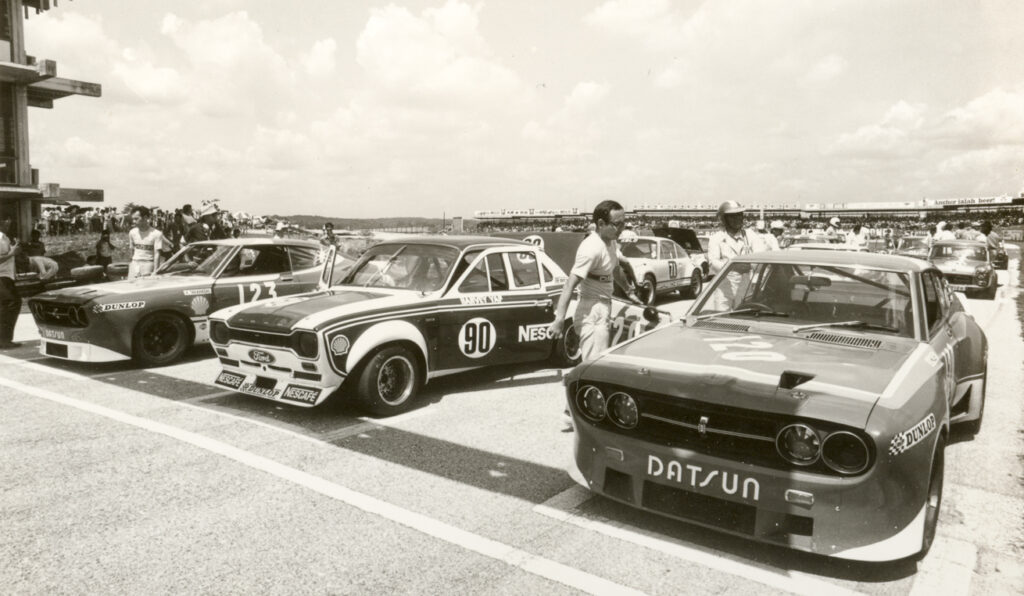
Nineteen cars were entered for the Improved Tourers race – and this was just cars 1301cc and higher Heat. A glance at the Singapore Motor Club’s April 1974 Gazette “Track Talk” by Porsche man Keith Dinnerville reveals what was cooking: “There is a rapidly growing interest in Improved Touring cars, mainly in the area of big cubic capacity machinery. Probably the most interesting big “banger” acquisition is the ex-Allan Moffat Ford Falcon GTHO by Ian Grey. Ian, along with several other exponents of ‘cube’ brigade, see a good competitive future emerging, plus the interest race fans are showing for this class of motor racing. I must mention some of the recent Improved Touring cars. John Smith and his big [Singapore road registered] ‘White Hunter’ Holden Monaro; Ian Grey’s 911S Porsche, the ‘Yellow Peril’; Harvey Yap’s ‘Expresso’ Ford Escort BDA and Jim Taplin’s ‘Blimp’ Hillman Ford, and the list goes on.”
The new Ford Escort arrived in Singapore from Melbourne on Saturday 23 March 1974. Together with Ian Grey’s Falcon GTHO, the cars were trailered over to the Batu Tiga Circuit and given track time on Sunday 31 March 1974. Both cars apparently ran well with very impressive times set. Harvey also had the luxury of three mechanics from Universal Cars Malaysia plus Bill Santuccione, still the Performance Programs Co-ordinator for FasPac, at his disposal. It was Bill’s responsibility to secure the purchase of the car as well as all its related participation in the region. As Bill explained, the plan was to have Harvey race outside of Malaysia as Ford’s Asian works driver.
On the Improved Touring Cars grid, Ford had but that one works entry – the #90 Team Nescafé-Ford Escort Brain Hart alloy-block BD. Datsun’s local distributor Tan Chong had four cars entered: a pair of 1,810cc 160J SSS Turbos for Abdul Malek and Takahashi, and a pair of 1,595cc 160Js for Lee Kwai Leong and Kenny Lee. Ian Grey’s GTHO entry didn’t materialize and it was back to his trusty 911S. Ain’t no replacement for displacement would have to wait another year.
Takahashi stole pole and the Ford ended up in a Japanese Dat-sandwich. But Takahashi’s Datsun motor wasn’t running at its best and Harvey romped to a fine victory over his master, dominating from start to finish and winning the 25 lap race ahead of Abdul Malek in the second Team Datsun 160J SSS and Ian Grey in his 911S. Even with their RM$250,000 annual budget it was still Ford 1, Datsun O but it took some thinking and a lot of work before the Ford could beat the Datsuns off the line.15

BANISHED FROM BOREHAM
BANISHED FROM BOREHAM: So here’s the second Ford Escort myth. Was Harvey’s Escort a new import from Lot 6 or the ex-Moffat car (V1) following a Lot 6 makeover by John Wynne? Here’s where photos don’t lie. V1 had rectangle headlights, V2, the 1974 entry, had round lights. The wheel arches were different, as was the front apron. Missing was the cut out on the bonnet for the fuel injection pump. The car now had a front quarter glass on either door. While these may be superficial and reversible, headlamps never tended to be switched, nor were front valences and grilles. And here’ where the late Graham Robson, renowned Ford historian, comes in.
Robson noted in his Works Escorts In Detail (Herridge & Sons, 2012) that “Because British Touring Car Championship rules were changed for 1974, with a modified version of FIA Group 1 being imposed, the amazing little BDH-engined (1.3-litre screamer!) Escorts were outlawed, and all had to be either scrapped, or their engines had to be sold for other uses. At the end of 1973 therefore, and with British motorsport temporarily banned because of the Energy Crisis, YOO 331L was returned to Boreham and was put in store for many months. It was not raced again in the UK, and was eventually sold to Ford Australia, apparently without its ultra-special engine.” Chassis YOO 331L was first registered on 24 April 1973 and was a GT model. Harvey’s second Escort was a GT model as well and the timelines match. At Lot 616, John Wynne, the genius with metal, started working on the car from Boreham. The wheel arches were sourced from the Ford Escort spare parts catalogue, using inner wheel arches and grafting them to the outside to accommodate the wider 13in wheels and tyres. They were neatly executed and the car was extremely light. As Wynne recounted, aside from the Titanium wishbones used, the “hang-on” metal panels were acid-dipped to lighten them even further. Perhaps V2 was VOO 331L, perhaps it wasn’t. The experts will know better.
This was serious racing and as soon as the Selangor race weekend was over, the Team Nescafé-Ford Escort was flown back to Melbourne where further testing (by Allan Moffat) and development continued. The Penang races were to take place on the end-August/1 September weekend, the first of back-to-back weekends of racing (the Selangor Grand Prix was the weekend after).
The car arrived late in August and was sent straight to the Batu Tiga circuit in Selangor for Harvey to try out. There was a new BD engine, said to put out a very optimistic sounding 325bhp! Bill Santuccione laughed when I mentioned this number to him. His reply was, “Scaremongering with the competition never went astray.”
Along with the car came a new Racing Manager and boss of Ford Malaysia, Ian Pagent. Bill was still coordinating things but Howard Marsden, Al Turner’s successor in the special vehicle operations, preferred Bill to stick around in Melbourne to assist with the Australian saloon car racing as he was spending far too much time travelling to South East Asia and New Zealand. Pagent had been in Kuala Lumpur at the end of 1972 to establish a sales and corporate office17 and you see his presence alongside Bill (and sometimes Joseph Auton, Ford Singapore’s MD) in the photos of the V2 Escort in 1974 and 1975.
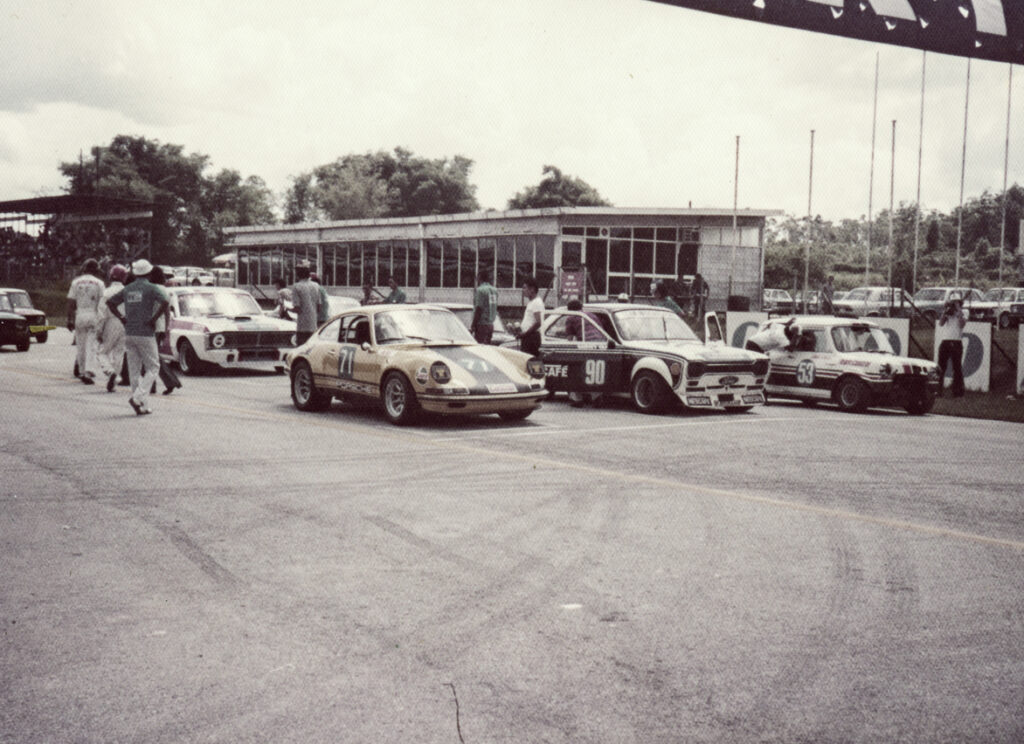
MONEY MONEY MONEY
MONEY MONEY MONEY: Anne Wong, Singapore’s speed queen of the early 1970s, remarked in her regular At The Wheel newspaper column that, “…it is the Saloon car races, especially the battles in the Improved Saloon car races which draw the crowds. Everyone I spoke to agreed with this. Yet why isn’t the prize money higher?” That was certainly true vis-à-vis the single-seater Grand Prix and the motorcycle Grand Prix. Perhaps it was because the small prize money wasn’t as important to the works teams in the Super Saloon class as was the overall win and potential vehicle sales that would follow an outright victory. Holding the Penang Circuit Races (at it was then known as) before the Selangor Grand Prix perhaps saved the street race from extinction during the mid-1970s, and while the Production Car and single-seater races were popular amongst competitors, the Improved Touring Cars weren’t so hot amongst the budget-conscious local racers.
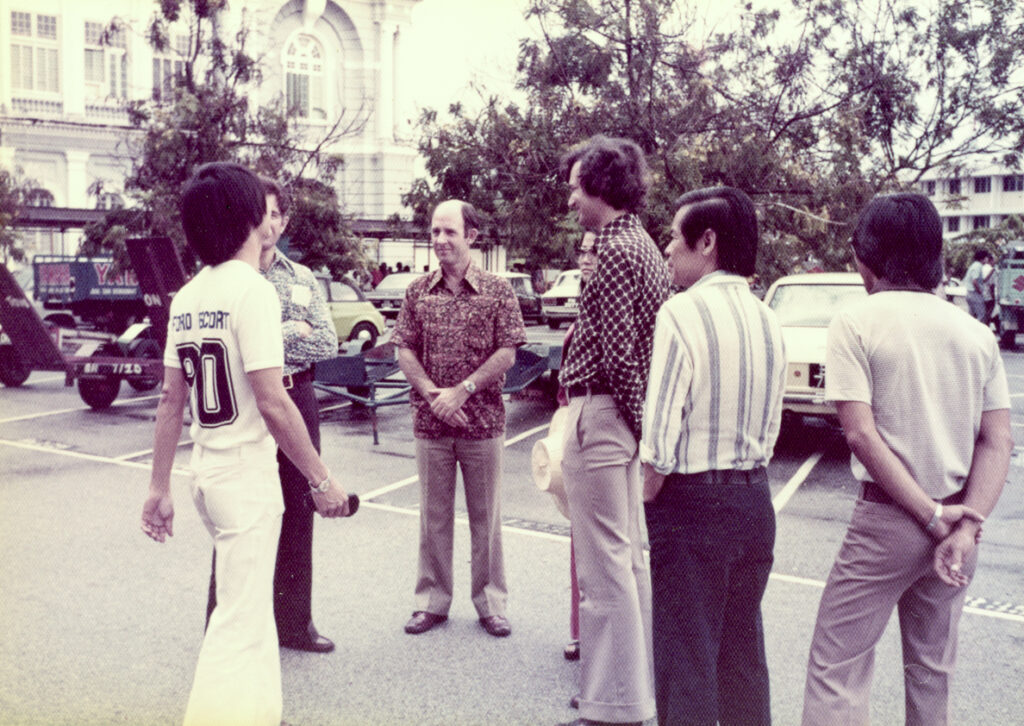
This time round, Datsun’s star drivers weren’t present – the 160J SSS Turbos would show up a well later. Still, in 1974, Penang’s entries included the sole Ford works car, two works/ex-works cars from Britain and an Alfa Romeo GTAm (minus City Motors stickers this time18) that was long in the tooth. The two British cars didn’t make an impression in the races though they did attract a great deal of spectator interest. The GTAm had been mothballed and needed more track time and a lot of work to match the lightweight Minis.
Harvey Yap won the 25-lap (the official program listed it as 35-lap race) Improved Touring Cars race that Sunday though it was hardly a grid to brag about with William Mei in a Mini battling it out with Albert Poon’s Alfa Romeo GTAm for second place. Brian Tyler finished 4th in his Gp2 Vauxhall Viva, of which more anon.
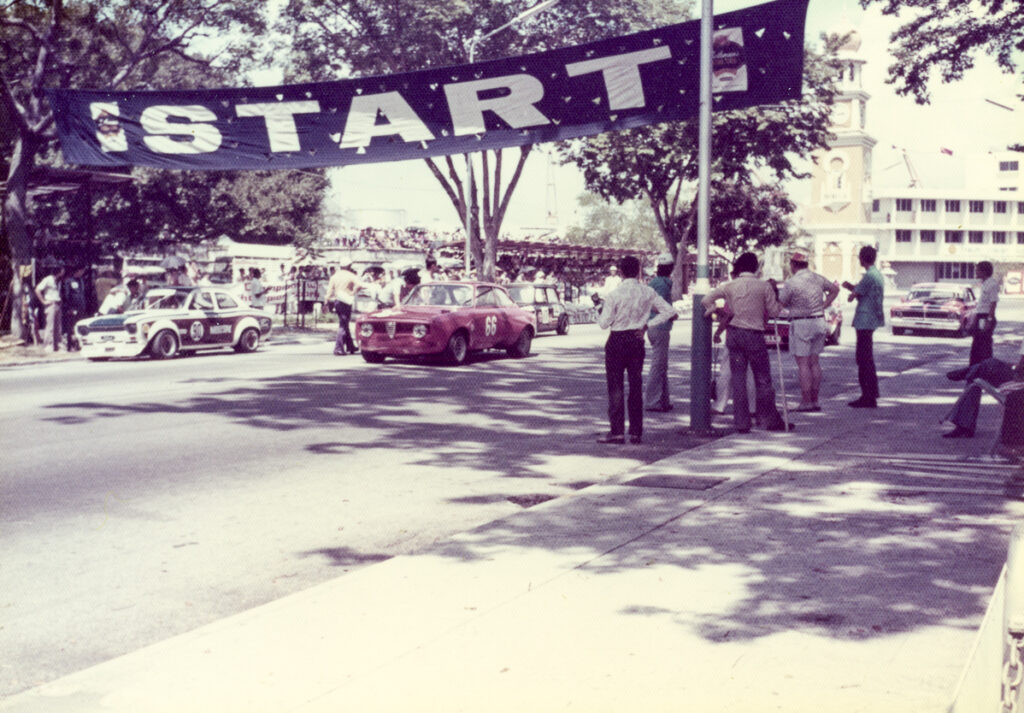
ALL ABOUT WORKS
ALL ABOUT WORKS: 150 entries was a new record for the Grand Prix in Selangor held the week after the Penang races. This was now the glamour of the Grand Prix weekend and the entries reflected this. There were now two works Ford entries. One was the Team Nescafé-Ford Escort following a winter rebuilt and test program in Australia. The other was the Team Nescafé-Ford Cologne Capri for New Zealander Paul Fahey, a car with a formidable history of victories under its belt. Team Datsun were present as well and had been developing their turbo 160J SSS cars, the Takahashi car already setting a new lap record at Batu Tiga in mid-week practice. Teammate Lee Kwai Leong too was much better prepared for the showdown, having spent a couple of weeks training in Japan in February.
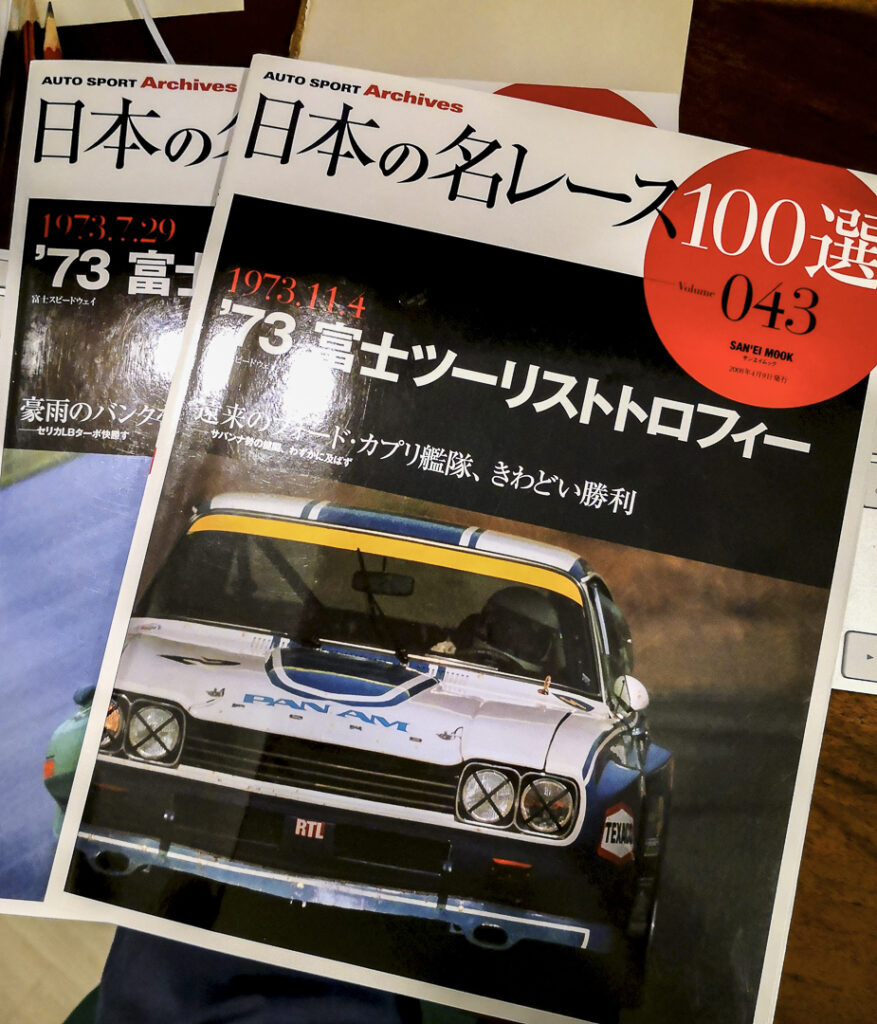
From Hong Kong, John Macdonald, better known for his single-seater exploits, had British Leyland/Cathay Pacific support with a Broadspeed-tuned 16V single cam twin Weber Triumph Dolomite Sprint. This was reputedly the first Group 2 Dolomite Sprint produced and came from Metro Dodwell where John’s mate and team manager, Alan Dingle, was MD. The Dolly Sprint had flopped in Penang the week before, an oil pressure issue but it was an impressive showing for the $60,000 car (plus a further $60,000 worth of spares). Even Ralph Broad of Broadspeed was there, as was Steve Harvey, Manager of the British Leyland Far East Competition program. Local driver Percy Chan, Malaysian Motor Sports Club’s Captain, was racing a single-seater March 722/732 that weekend. Percy felt that Macdonald wasn’t quite aware of the strength of the saloon car opposition and that the Wearnes Team Leyland Triumph Dolomite Sprint wasn’t quite in the class of the BD Escort, the V6 Cologne Capri RS2600 or even the 2,517cc 160J Turbos.
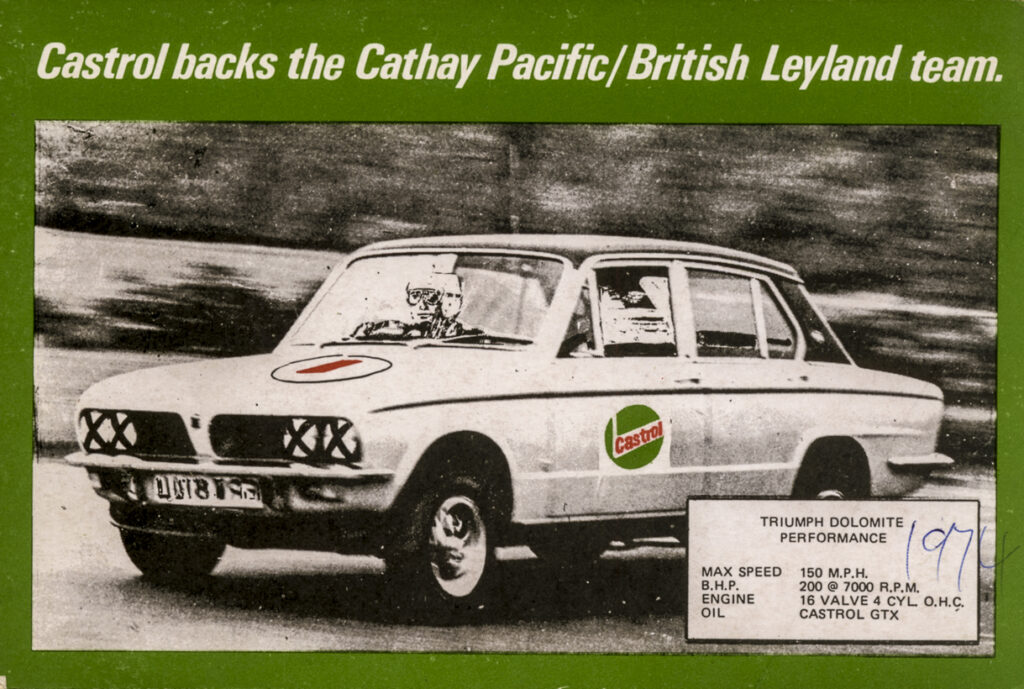
It seemed everyone was getting into the act, including vintage car owner Brian Tyler with what was rumoured to have been the ex-Gerry Marshall 1972 British Saloon Car Championship works fuel injected Gp2 Blydenstein-engined Vauxhall Viva (2,279cc OHC). Then there was the ex-Ian Grey Ford Falcon GTHO (5,700cc), now with American Del Schloemer and a Holden Torana V8 (6,900cc) entered by Jim Pinkley, making up a 35-car grid (only 30 would qualify for the 25-lap race). This was impressive stuff for a circuit lying in the outer fringes of the motor racing galaxy.
Race 4 was for the 1301cc and larger Improved Touring Cars over 10 laps and was run on Saturday the 7th at 11.15 am. Takahashi had an early lead, chased by Fahey in the Cologne Capri19, Lee Kwai Leong in the second 160J, Harvey Yap in the Escort, Ian Grey in his 911S and Brian Tyler in the Vauxhall Viva. The Capri rapidly lost ground midway through the session and Takahashi relinquished his lead at the last lap and let Lee Kwai Leong overtake him. It was a sweet 1-2 for Team Datsun with a new lap record of 1:29.5 set by Takahashi, beating his previous lap record set in April.
Harvey however, had started from the back of the grid for this Heat (he missed the first heat) The BD engine only arrived late on the Thursday before race weekend and this meant that Harvey missed official practice on Friday and would have to start from the back of the grid for the first heat. At the end of the session, he was a good ten seconds behind Lee after 10 laps. Paul Fahey however was less upbeat, the highly touted Capri was overheating though a 1:30.5 fastest lap held some promise, if they could sort out cooling issues.
The qualifying positions for Sunday morning’s 25-lap race would be: Lee Kwai Leong (160J SSS), Takahashi (160J SSS), Harvey Yap (Escort BD), Ian Grey (Porsche 911S 2.4), Paul Fahey (Ford Capri RS2600), Brian Tyler (Vauxhall Viva 2.3).
Harvey’s electrical issues (the distributor clamp bolt snapped) at the start of the Sunday Race forced him out of the race. Takahashi had his revenge and won easily ahead of Paul Fahey in the RS2600 Capri, Del Schloemer in the Falcon GTHO, Jim Pinkley in the Holden Torana and Teo Eng Bok in a 1.6-litre Ford Escort Twin Cam. Bill Santuccione quickly ensured such gremlins would not resurface again and a new BD engine was ordered for December’s Malaysian National Open Championships. The car had probably been developed to its maximum by the time it returned to Selangor, new twin brake calipers, adjustable shocks and ride height, roll stiffeners, you name it they’d addressed it. Even so, they were soon incorporating Cologne Capri ideas into the development of the BD engine for the Escort.
In December, the Malaysian National Open saw Bill Santuccione and his team rush to get the Ford Escort ready for the races with the rebuilt BD motor. The December event received more publicity due to the return of City Motors’ Team Alfa in the Series Production races with an eight-car team of Berlinas. Mazda had a fleet of rotary REs entered as well, as did Datsun and Ford. The biggest shock came a week before the event when Tan Chong’s Advertising Manager Ridzwan Ariff dropped a bombshell when he revealed that they had pulled the Datsun 160J SSS Turbo entries for Lee Kwai Leong and Abdul Malek on the back of budgetary issues over developments in emission controls.
Even without the Datsun 160Js, Harvey and his Escort did not have it all his way. A wiring fault minutes before official practice, run in heavy rain, put him at the back of the grid for the second heat of the race. Alongside him at the rear of the grid was Singapore-based American oil rig project manager, 41-year-old Del Schloemer in the monster of cars, the Falcon GTHO.
NEW THREATS
NEW THREATS: There was now a new contender in the Improved Saloons race this time, Kenny Lee in his #83 Team Duckhams Mazda RE (rated at 2,292cc). Lee’s Mazda RE was previously a rally car, converted for circuit racing over the course of three months (and RM$7,500) after Lee convinced Mazda agents Asia Motors to release the car and help fund the conversion which service manager Stephen Lam agreed to. An attempt to convince Mazda’s Toyo Kogyo to provide the local racer with an RX3 Savanna failed, leaving Lee with the RE, nicknamed 6611. The 1,146 Capella Rotary M12A motor was ported at Dairen Engineering off Klang Road and the chassis was re-engineered at the Asia Motors Petaling Jaya Service Centre. There were aluminium doors, Perspex windows, a 4-speed close ratio transmission and LSD, amongst other things that had been done no the car.
There were issues faced with the Brian Hart alloy head in Harvey’s BDA, a clogged filter in cylinder head causing the cam belt to break. It was such a rush for the crew to get the car ready for Sunday’s race that they bolted off to Batu Tiga while Bill Santuccione put the finishing touches to the car at the Universal Cars garages in Kuala Lumpur. So rushed they were that they had inadvertently taken the tow car and trailer with them.
Bill completed the engine rebuild but without a trailer he had to come up with something fast. “Put your tool box at the back and we’ll drive to the circuit,” he instructed the last remaining Universal Cars assistant. “We’ll drive there. If we get stopped by the police, I guess we can’t make it,” he recounted. So they drove from Universal Cars to Batu Tiga in the Nescafé car. Harvey didn’t know if he’d have a car to race but he pulled enough strings to keep officials from flagging off the event, just enough for Bill to make it through the Batu Tiga gates for a quick driver change.
When the flag dropped for the first heat, Harvey let Del Schloemer carve an opening that saw both cars emerge first and second within laps. Harvey then slipped past the big Falcon for a satisfying victory that saw just the Falcon and Ian Grey’s 2.4-litre Porsche on the same lap at the end of the 20 lap heat. Kenny Lee’s pole evaporated following mechanical issue, the up and coming saloon car star finishing in 6th. In the main race over 40 laps, a depleted grid (a partial Singapore boycott) reduced the spectacle to just 11 cars of the 20 entered. Harvey Yap and Team Nescafé-Ford had no difficulty winning. And so ended the 1974 season for the team.
Time was running out for the Mk1 Escort and the new square-rigged Mk2 Escort would soon be released, even if it were an aerodynamic backtrack compared to the design of the Mk1.
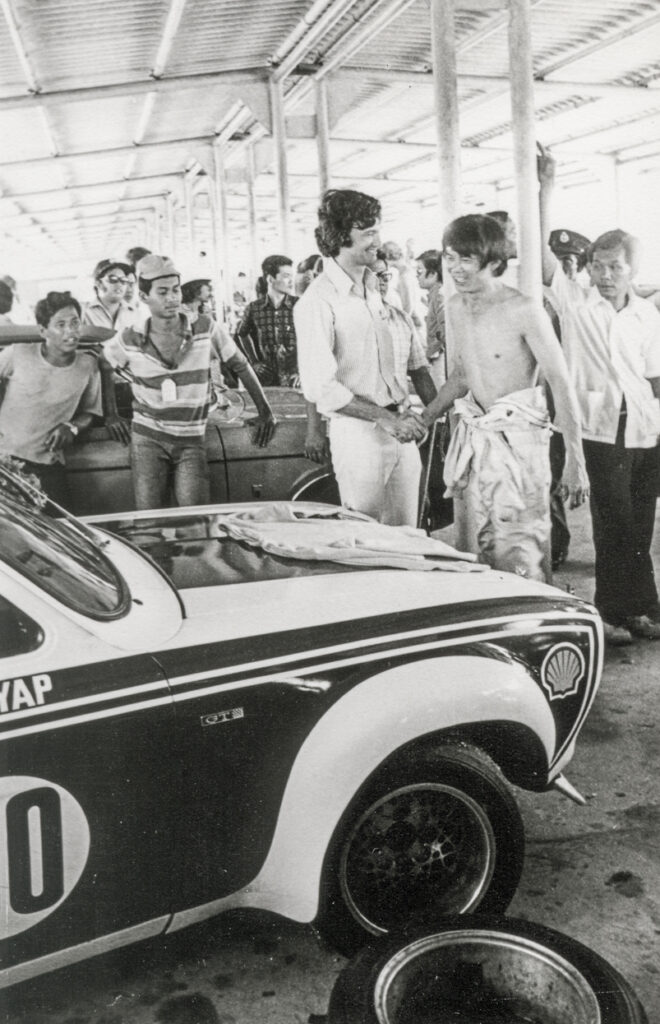
LAST FLING
LAST FLING: Typically the March-April Malaysian Grand Prix never attracted a fancy grid of big names in the Improved Touring Cars class. So for 1975, the organisers replaced the category name – Improved Touring Car would henceforth be Super Saloons ‘Unlimited Formula’. The winner of the 30-lap race (Race 9, 11.00am on Sunday, 30th March 1975) would receive the Nescafé-Ford trophy. The prize money for this support race to the Grand Prix single-seaters was still dismal – $800 for an overall win versus $5,000 for the single-seater race and $3,000 for Grand Prix motorcycles.20
The name change allowed for freedom of engines but the side profile of the cars had to remain unchanged. Simply put, this was now Silhouette racing and the start of a new era. This class was still dominated in Asia by enthusiasts who could afford to acquire and race cars while the professional racers stuck to single-seaters for the financial rewards. The exception was Harvey Yap, employed by Ford and backed by Nestlé’s.
A glance at the Super Saloons grid for the 30th March 1975 race was enough to understand how things stood. With more than half the grid filled with Minis and just two drivers backed directly by the distributors, it wasn’t hard to see that unless something was done to attract key sponsors, boost prize money and offer starting money, in time there would not be a Super Saloons support race, or even a Grand Prix.
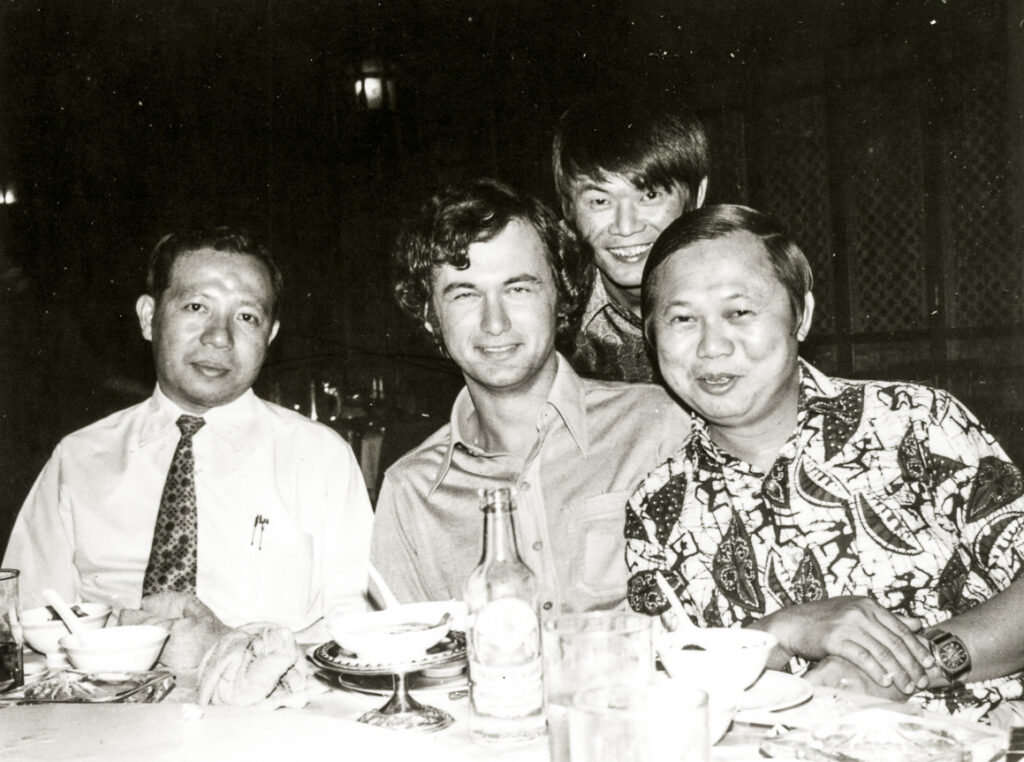
SMOKE SCREEN
SMOKE SCREEN: Rothmans were one of the biggest financiers of the sport in Malaysia and indeed globally but there was more that was needed to boost interest in the local Grand Prix and key supporting races which the 1974 Secretary of the Meet, Rothmans’ Chin Kui Yin (generally referred to as K.Y. Chin) was scratching his head over. Chin was also Rothmans’ Team Manager21, instrumental in supporting the acquisition of the March 732 cars that permitted drivers like Sonny Rajah, Percy Chan, Jan Bussell, Harvey Yap and Pocholo Ramirez to race in the early and mid-1970s.22
Sitting on the General Committee of the MMSC as well as being Secretary of Race Organising Committee of for the Shah Alam races meant Chin was in the thick of things from 1974 until just after the formation of the Shah Alam Motor Racing Association (SAMRA) in 1978. The aim of the race committee was to attract top drivers from the region and around the world, ensure that there was starting money, raise the prize money for the racers and keep things exciting. The MMSC were the controlling body of the sport in Malaysia in the early 1970s, until the formation of SAMRA.
Rothmans backing was significant, not just as title sponsor but for the drivers and the cars Rothmans funded. In fact, Harvey Yap sprung a surprise when Rothmans backed his entry in the single-seater for the Malaysian Grand Prix in March 1975 with a March 732/72223 Formula Atlantic the company purchased for Percy Chan to race in April the previous year. This was Harvey’s debut in top flight Atlantics and he wasn’t far off the pace, qualifying 3rd, behind the more powerful cars of John Macdonald (Brabham BT40) and Albert Poon (Chevron B29). Percy, meanwhile, had financial support from Rothmans and was able to loan Sonny Rajah’s March 732/712M24 for the weekend while the latter entered a spell of semi-retirement following a year of racing in the Australia Van Heusen Formula 2 Championship.
In the Super Saloons race, Harvey had competition from a rapidly improving Kenny Lee in the Mazda RE Rotary. This time around, Ian Grey’s wasn’t the only Porsche on the grid, although by March he had replaced the 2.4-litre flat-six motor with a 2.7-litre Carrera motor, flared arches, lower-profile tyres and a bunch of racing components from West Germany, thanks to the work of his friend and chief mechanic Keith Dinnerville. The other Porsche Carrera came from Hong Kong, driven by Adrian Fu (the Fu in Hong Kong’s Furama Hotel). There were a couple of other Hong Kong entries – Mike Jean in an ex-works Gp2 Toyota Celica GT and Peter Chow in his yellow ex-works Gp2 Chowini Celica, the Chowini Celicas making their maiden visit to Malaysia though Peter Chow (the Chow in Chowini) himself had raced in one of Dato Foo Wan Kien’s production Alfa Romeos earlier. The Chowini Celicas would soon be a familiar sight at Shah Alam (there were seven Chowini Toyota entries in the 1977 Malaysian Grand Prix!) but were always going to be disadvantaged as Malaysia’s Super Saloon formula far exceeded Gp2 specification for the Macau Grand Prix Guia races.
The big bangers were still lurking in the background – and Del Schloemer now had a 5.7-litre Camaro to add to his Falcon GTHO. However, the Camaro had been miss-shipped to Hong Kong and only arrived in Kuala Lumpur by air a day after the races. His GTHO busted a cam before the race and Del DNS-ed.
Harvey Yap won both the races this time out with Adrain Fu second in his 911S, Kenny Lee third in the Mazda RE in both the races as well. The Brian Tyler Blydenstein Viva was fourth. Grey blew his new 2.7-litre Carrera motor in practice and rebuilding the 2.7-litre flat-six in time for race day was simply out of the question for the mining engineer.
LAST HURRAHS
LAST HURRAHS: The Penang Circuit Races were held over the 31 August–1st September 1975 long weekend. Once more it would be a Harvey and Ian Grey on the front row. Harvey won, Ian was second and James Knight, in a 1293cc Mini, occupied the last podium slot. More importantly, Harvey also raced the Rothmans March 732/72225in the Grand Prix (he was on the front row of the gird, second quickest), which must have been far more engaging for him than having to race around Penang against non-works tin tops. He DNF-ed in the March with a damaged rear upright. It would have been a very different experience from driving a saloon car around the streets. Penang took no prisoners.
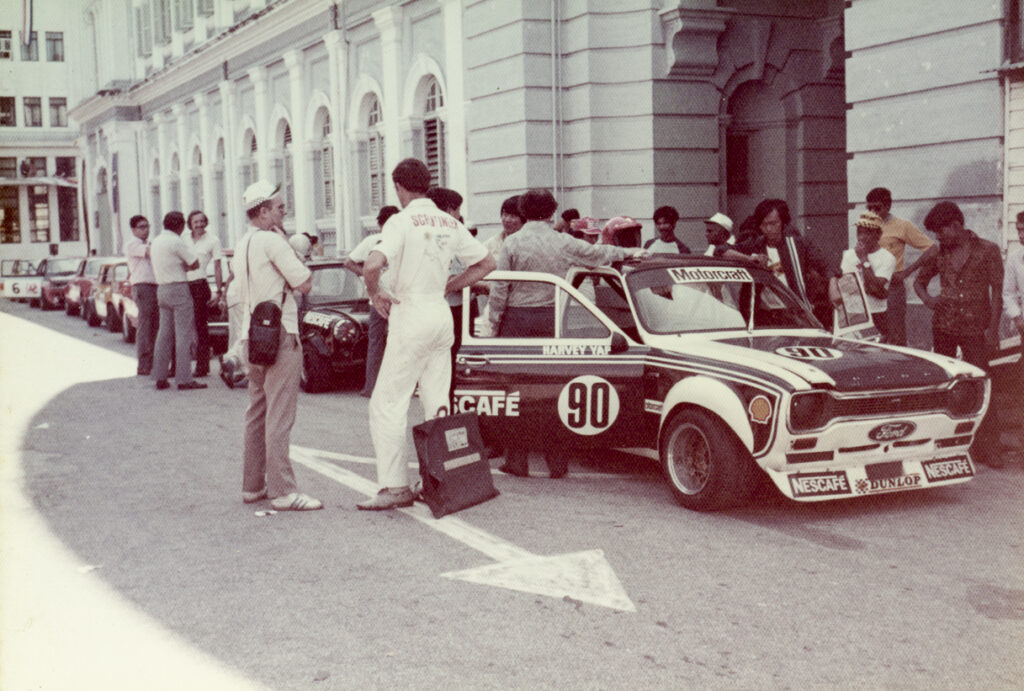
This brings us to V2’s final showing in Malaysia, the Selangor Grand Prix that was held between 5-7 September 1975. A terrorist attack by the Malayan National Liberation Front in the Kuala Lumpur on the Wednesday before Selangor Grand Prix, the second such attack in two weeks, did not deter participants from making the trip over to Shah Alam on Thursday and Friday for practice and qualifying.
Super Saloons Unlimited grid consisted of Harvey in the V2 Escort, Ian Grey in his 2.7-litre 911S, Keith Walker in an aged Datsun SSS (that would soon morph into a Dat-Ford), Indonesian Abeng Suswanto26 in an Albert Poon-entered 2-litre Opel Ascona (Albert apparently had sold the Ascona to Beng), Del Schloemer in the Camaro and Jim Pinkley in a wild-looking 5.3-litre Torana with V8 power he called the Jessie James Chevrana. Kenny Lee was not entered in his Team Duckhams Mazda RE Rotary and the 23 car grid was padded by 13 Minis that were never going to pose a threat to the front runners for an overall win. The second Camaro entry (Ian Grey) never materialised.
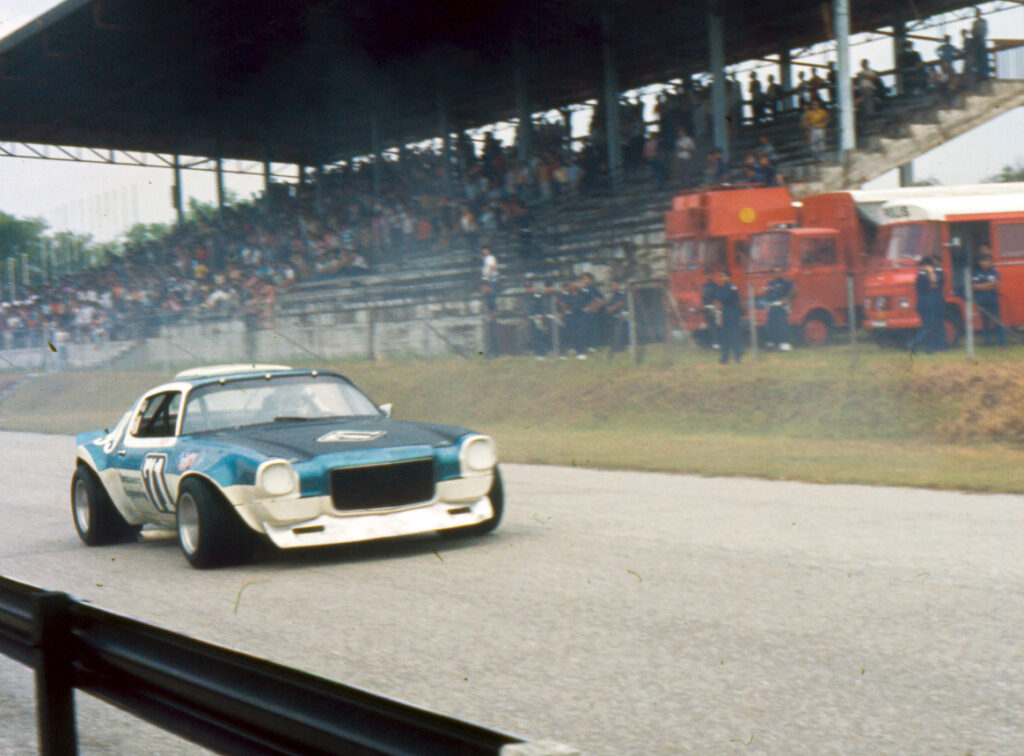
Grey won Heat 2 on Saturday in a good battle with Harvey until the Escort’s ZF gearbox failed. Harvey was on pole for Sunday morning’s Finals, having set a 1:33 in qualifying. Gray was second in the 2.7-litre Porsche. Del Schloemer and his second generation 350 cu in Camaro were at the back of the grid. The race saw another tense battle between the Malaysian road-registered Porsche and the Ford Escort…until the BD motor expired “in a great cloud of blue-white smoke on lap seven.” It was a sweet victory for the Singapore-based Australian (he had relocated to Singapore from Johore in 1973) and the first Super Saloons win for the Porsche since its first outing at the Malaysian National Open at the end of 1972 (it had started life as a stock 2-litre 911S). The late arrival of Del Schloemer’s #98 5.7-litre Camaro meant the V8 Camaro had to start at the back of the grid. Del spent three laps in the pits…but still finished second!
It is unlikely Ford sold V2 locally following the race. September was the last time it was raced in anger at Shah Alam. The car had reached the end of its development potential.
TIME OUT
TIME OUT: Harvey sat out the 1976 season, the first time he hadn’t participated in the Malaysian Grand Prix in nine seasons. It appears that V2 had returned to Boreham for a full rebuild and was meant to be sold (for an estimated ~RM$80,00027, around £18,000/USD32,500) though it is not known what actually happened to the car. The single-seater GP and series production races were dominating proceedings and the Super Saloons had lost a bit of its lustre and publicity. Ford and Nestlé’s direct involvement had been curtailed and it was time for new sponsors and new cars to entre the market.
In February 1977 Harvey, then a Service Manager at Ford Malaysia, visited the UK for a racing refresher at Tony Lanfranchi’s Racing Stables at Brands Hatch. He was also there to oversee the finishing touches to Ford’s newest Escort for him to race in Asia – the 2-litre Mk2 RS1800 Escort (which arrived in Malaysia on 7 April 1977). The new Group 2 car plus spares for two seasons of racing cost Ford Malaysia approximately RM$250,00 or about USD103,000 per season, not a small sum by the standards of the day and when a Ford Escort Tudor 1100 was priced at $9,603, a Cortina 1600L at $12,309 and a Cortina 2000E at $15,559 (these are listed prices in local currency).
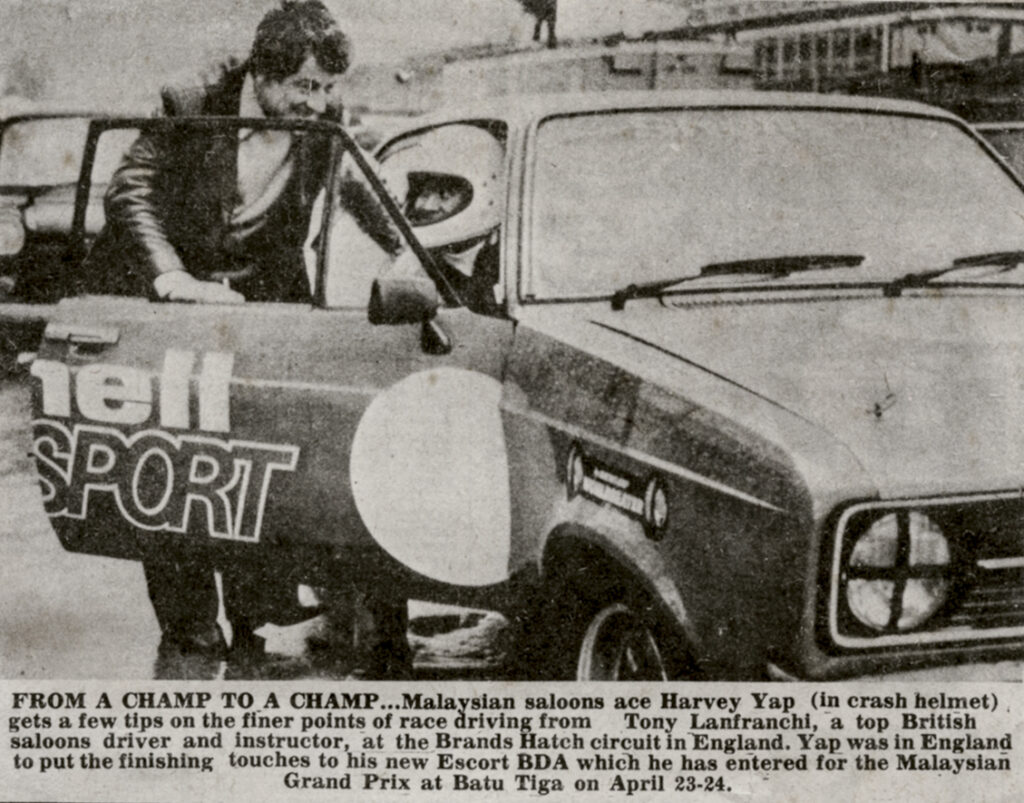
There was a new sponsor for the car – KFC-RAM Industries and Harvey had Mick Webb28, Allan Moffat’s 27-year-old chief mechanic with him to oversee the car as well as the Series Production Ford Escort Harvey was to drive. We’ll leave it at that and let someone else write about the Mk2 Escort that the locals refer to as the KFC Escort.
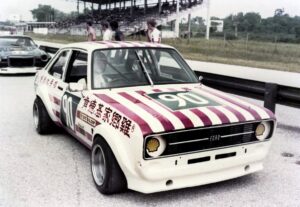
POSTSCRIPT
POSTSCRIPT: That, in a nutshell, is the history of the two Ford Escorts (V1 & V2) that raced in Manila, Singapore, Selangor and Penang between 1973-75. Interviews were conducted with Ford’s Al Turner and Bill Santuccione, Harvey Yap, Albert Anthony of Rothmans Pall Mall of Malaysia, John Macdonald, Angus Lamont, Rodney Seow, Kenny Lee, Peter Chow, Beng Suswanto, Eric Ooi, Nick Van Nugteren, Brian Tyler, Billy Mei, Ford guru and motor racing historian Ross Vasilakis, Asian motor racing guru C.H. Fu, Philippine racing historian and rally driver Martin Galán, and many others over the course of 20 plus years.
You may find numerous inaccuracies in this article, or you may recall the races/cars/people featured within. Please feel free to leave a comment or two here. This is non-commercial Website and the work of an amateur with a passionate interest in the preservation of regional motor racing history.
If you wish to copy the content/image for social media use, a kind mention of this website would be appreciated. If you wish to use this material for commercial gain, please drop [email protected] a note before doing so.
Written by: Eli Solomon
Footnotes
- Looking at 1972’s Malaysian Grand Prix Saloons & Production Sports grid (25 lap race), one notes the breadth of cars entered: 1-litre Toyota, Mini Coopers of various capacities, works Datsun SSS, Alfa Romeo GTAm, BMW 2002Ti, Ford-backed Escort FVA, Opel Commodore GS, works Datsun 240Z…it was certainly a solid list of entries and it was early days yet. The automotive industry latched on and now organisers were soon able to include classes for Series Production cars as well as for locally assembled cars as Malaysia had a growing automotive assembly industry. What this did was allow organisers to segregate the super performance cars into a whole new category – first referred to in Malaysia as Improved Touring Cars. This was first seen in 1972 in Malaysia and continued until it too was split into three separate classes of racing, one for Series Production Cars and the other two for a Saloons ‘Limited’ Formula* and Super Saloons Unlimited from 1975. * This was previously known as the Clubman Racing Class with engine modifications limited to internals but not to carburettors, inlet and exhaust manifolds.
- Malaysia’s economy experienced two inflation shocks in the course of eight years between 1973 and the early 1980s. The first was in 1973-1974 with inflation at 14% and the other in 1980-1981, when the rate of inflation rose to 8.2%. In 1974, in the wake of the OPEC oil crisis, Malaysia experienced its highest inflation rate (18%) of the decade. What mitigated the problem was that between 1976 and 1980, significant oil and gas reserves were discovered in the South China Sea. Oil revenues helped fuel the economic boom with Petronas, the state-owned oil company, running all aspects of oil extraction and production. By 1979, the economy was growing at an annual rate of 5.2%, and the manufacturing sector at 8%, driven by light industry and electronics. Monetary policy saw Malaysia floating the Ringgit in the in international currency markets in 1973. Initially valued at RM2.45 per US$, Bank Negara Malaysia (BNM) intervened in the currency markets to steady its value. Industrialization required heavy external borrowings.
- Red Flags – Motoring in the Far East. Unpublished manuscript by the same writer.
- Michigan Motor Sports Hall of Fame – https://www.mmshof.org/index.php/inductees/inductees/403-turner-al
- See Max Gregory, The Society of Automotive Historians, Issue No. 50, December 1976.
- Mr Repco Brabham – Frank Hallam, by Simon G. Pinder. Pinder Publications, 1995.
- Once the Batu Tiga race circuit had opened its doors in 1967 [see Racing In The Federal Capital], the complexion of racing in Asia changed dramatically. No longer were organisers limited by the number of races that could be held over a weekend, the racers themselves were able to hone their skills over a longer period of time, improving the racing, improving quality of driving and ultimately improving the quality of sponsorship prepared to back local competitors. Back in 1972, it was all rather simple. A Grand Prix for cars with a cash reward of $5,000 for the winner (depending on size of grid), a race for Saloons & Production Sports Cars with a cash reward of $1,500 (again depending on size of grid), and a race for Sports & GT cars (which was soon to be removed entirely). The motorcycle Grand Prix prize money wasn’t far off that of the GP cars that the bike experts in Singapore and Malaysia would have already written extensively about.
- Allan Moffat – Climbing the Mountain. By Allan Moffat with John Smailes. Allen & Unwin, 2017.
- Harvey Yap felt that the punctures were due to the low profile tyres being underinflated earlier – they were running pressures in the low 20 psi range. Bill Santuccione notes that the recommended operating pressures for the Escort was relatively low and the tyres would move on the BBS rims. Bill followed aircraft principles and added studs on the rims to engage with the tyres. This was done with the Escort’s alloy BBS rims at an engineering shop at Subang Airport in 1973. Sealing of the studs was done using epoxy at the Petaling Jaya Hilton Hotel at Al Turner’s room. Bill then sealed Al Turner’s toilet set as well.
- Bill Santuccione recalls that V1 returned to Ford Australia. It was still a very fast car but outdated and was converted for use in Rallycross for a short period of time, using the rear suspension of one of the two Capri rally cars that Ford had in Melbourne.
- The design of the Batu Tiga Circuit was modelled after the new Surfers’ Paradise Circuit in Queensland which had opened in 1966. Companies Rothmans, Philips, Omega, Tiger Balm, Goodyear, F&N, Cold Storage, Nestlé and Wearne Brothers in Malaysia each contributed a substantial amount of money to the construction of the Batu Tiga cicuit. On 29th August 1967, His Royal Highness, The Sultan of Selangor laid the foundation stone for Selangor’s race track. It was initially called the Batu Tiga (third milestone) Circuit, and as the township of Shah Alam grew, it was later referred to as the Shah Alam circuit.
- BLUE OVALS: 1968 Ford Motor Company, USA (Ford) entered into a 10 year dealer assembly agreement with Universal Cars and Associated Motor Industries of Malaysia (both were wholly owned subsidiaries of Wearne Brothers Ltd). Wearne Brothers Ltd. was involved in importing, assembling and distributing Ford motor vehicles in Malaysia. Universal Cars operated Singapore’s sole Ford dealership and three dealerships in Malaysia and was one of the oldest Ford franchise holders in the world. In 1972, Ford Motor Company of Malaysia Sdn Bhd (Ford Malaysia) was formed as a subsidiary of Ford U.S.A. (100% Ford owned). Ford’s marketing office in Kuala Lumpur and a parts and accessories store in Shah Alam were established by Australian Ian Pagent when he assumed his position as head of Ford Malaysia. The rest of the corporate history is best left to local Ford experts to write about.
- By which time the Lot 6 operations in Victoria had been wound up.
- Peter Ashcroft took over Ford’s Competition Department from Stuart Turner when the latter was promoted to head Ford’s Advanced Vehicle Operations. Prior to the appointment, Ashcroft had been seconded Ford’s Cologne operations working on the Capris.
- According to Bill Santuccione, the V2 Escort had a very tall first gear which made it difficult for Harvey to match the Datsuns when the flag dropped. Bill suggested installing twin windscreen washer reservoirs in the trunk behind the wheel arches so that his driver could give the rear tyres a squirt of water to help break traction when Harvey dropped the clutch at the start. The experimented with this but Bill wasn’t able to recall if Harvey tried it the races.
- There is some confusion as to what Lot 6 did with either of the Ford Escorts. By 1974 Lot 6 had been disbanded. V2’s work was subcontracted out.
- Ford’s Singapore Managing Director between 1971 and 1978 was Joseph G. Auton. Auton replaced R.B. Fawcett in June 1971. The latter was transferred to New Zealand as Ford’s MD there from 1 July 1971. Auton was a Ford career man. He left Ford Singapore/Malaysia in February 1978, replaced by H.F. O’B Reeve, who held positions in Ford Canada, Africa, Thailand and New Zealand. Auton was sent to Ford New Zealand. Ian Pagent’s arrival in 1972 as head of Ford in Malaysia coincided with Ford’s racing program in the Far East. Pagent had joined Ford in 1969 and would hold senior management positions for Ford in Australia, Malaysia and the US.
- Dato Foo Wan Kien pull out official City Motors backing following a debacle involving the disqualification of Peter Chow, one of his drivers, in the 1974 Malaysian Grand Prix Series Production races. Albert Poon was loaned the City Motors Alfa Romeo GTAm for the Penang Circuit Race, run as a private entry.
- The Kugelfischer fuel injected 3-litre Westlake-developed Cologne Capri was the second Team Nescafé-Ford entry. Its driver was not known at the time the official program went to print but the car was a known quantity in international saloon car racing, which the local papers reported was the car that was raced by in the 1973 European Touring Car Championship and the #2 car that Jochen Mass and Dieter Glemser raced in the Fuji Tourist Trophy Pan Am 500 on 4 November 1973 (there were two RS2600 3-litre Capris entered, the other was for Allan Moffat/Tonie Hezemans) and what the press also reported as the Bob Harper-entered car that Allan Moffat won in the 1973 Macau Grand Prix Guia.
- In April 1974 the MMSC (the General Committee included known names like Sonny Rajah, Paul David, David Coode, K.Y. Chin, Sonny Soh, Jeff Amin, Kenny Lee and Percy Chan) was looking at introducing a weight to power formula for the 1975 season. The intended changes meant that Harvey Yap’s BDA Escort would have to carry an additional 430 lbs of dead weight while the 2.5-litre Datsun 160J SSSs would have to carry 544 lbs. There were big protests from both the Ford and Datsun teams threatening to pull out. This later resulted in the Super Saloon class of racing. In August 1974, the MMSC had upped prize monies for September’s Selangor Grand Prix at Batu Tiga with the Improved Saloon driver prize pool bumped up by M$1,650 to M$5,300. Drivers and teams had shown their discontent earlier, citing that they were in fact the main draw card for the Grand Prix. They weren’t wrong and Wearnes, Ford distributors, came to their aid with a cash top-up. While the Grand Prix winner would receive M$6,000 and a motorcycle Grand Prix winner M$4,000, the winner of the Improved Saloons race would receive just M$1,250. A revision saw this raised to $2,000.
- See SMOKE GETS IN YOUR EYES: THE WESTERN PACIFIC MOTOR RACING CHAMPIONSHIP
- See RIDES OF MARCH – Part 1 & RIDES OF MARCH – Part 2
- See RIDES OF MARCH – Part2
- See RIDES OF MARCH – Part 2
- See RIDES OF MARCH – Part 2
- We are first introduced to Abeng Suswanto (better known as Beng Suswanto) in 1969 when he was entered to raced a Yamaha motorcycle in the Singapore Grand Prix. By 1971 he had progressed to racing a hot Austin Mini Clubman (1370cc) in the Saloon and Tourer support race for the 1971 Singapore Grand Prix., his #80 car finishing third overall in the 20 laps finals, behind Albert Poon (Alfa Romeo GTA) and Abdul Malek (Datsun 2000 SSS) and ahead of Johnny Leffler’s Newton Enterprises Broadspeed Ford Escort Twin Cam. In the Motorcycle races, Suswanto’s #37 125cc Yamaha won his support race and set FTD in the process. He later raced in New Zealand, acquiring Lola’s T460 development car which he raced in the 6-round Rothmans International Grand Prix series that included races in Malaysia, Indonesia, Philippines and Macau in 1977.
- The Malaysian Ringgit in 1976/77. The Interchangeability Agreement that bound Malaysia, Singapore and Brunei together meant the Malaysian dollar was exchangeable at par with the Singapore dollar and Brunei dollar until Malaysia withdrew from the currency union on 8 May 1973. On 27 September, the Malaysian government opted to go with a floating exchange race determined by a basket of currencies. For all intent and purposes, this writer pegs the RM$ at parity to the Singapore Dollar for this period (1970-1980) so RM$250,000 would equate to £59,000 or USD103,000.
- The arrival of the Mk2 Escort was timed for the Malaysian Grand Prix at Shah Alam (23-24 April 1977). The entry was now sponsored by Kentucky Fried Chicken. Mick Webb, then 27, was sent over from Melbourne in Mid-April to take on the job as Ford Malaysia Racing Co-ordinator. Webb had been chief mechanic to Allan Moffat for the Ford Falcons. Harvey was Ford Malaysia’s Service Manager and had spent time before the April races in the UK, putting finishing touches to the car and attending a driving school at Brands Hatch with Racing Stables (Tony Lanfranchi). The new car arrived in Malaysia on 7 April 1977 with enough spares to last two seasons of racing – at M$250,000 a season. The car was a Ford Escort RS1800 but with a Cosworth BD motor.

